Scientific Applications of Distributed Acoustic Sensing: State-of-the-Art Review and Perspective
Abstract
1. Introduction
2. Theoretical Background (Andrei A. Fotiadi, Dmitry A. Korobko, Kivilcim Yüksel, and Marc Wuilpart)
2.1. A Brief History of Fiber Optic Acoustic Sensors
2.2. Mathematical Formalism for Distributed ϕ-OTDR Sensing
2.3. Quasi-Distributed DAS Using Fiber Bragg Gratings (FBGs)
2.3.1. Probe Pulse Configurations: Single (Long) Pulse versus Double (Short) Pulse Interrogation
2.3.2. Multi-Reflection and Spectral Shadowing Crosstalk
2.3.3. Spectral Shadowing Crosstalk Mitigation
3. DAS in the Engineering Sciences (Andrey A. Zhirnov and Konstantin V. Stepanov)
3.1. Pipelines
3.2. Railways
3.3. Highways
3.4. Structures
3.5. Other
4. DAS in Geophysics (Boris G. Gorshkov)
4.1. Vertical Seismic Profiling
4.2. Surface Seismics with DAS
5. DAS in Biology and Other Natural Sciences (Artem T. Turov)
6. Acoustic Sensing and DAS in Humanitarian Sciences and Culture: Perspective (Yuri A. Konstantinov)
6.1. Fiber-Optic Acoustic Sensing in Humanitarian Sciences: Early Stages
6.2. DAS in Sound-Engineering: First Steps and Perspective
7. Conclusions (Yuri A. Konstantinov and Ivan A. Lobach)
Author Contributions
Funding
Informed Consent Statement
Acknowledgments
Conflicts of Interest
References
- Fang, Z.; Chin, K.K.; Qu, R.; Cai, H. Fundamentals of Optical Fiber Sensors; John Wiley & Sons: Hoboken, NJ, USA, 2012. [Google Scholar] [CrossRef]
- Kuznetsov, P.; Sudas, D.; Savelyev, E. Fiber optic Lossy Mode Resonance based sensor for aggressive liquids. Sens. Actuators A Phys. 2021, 321, 112576. [Google Scholar] [CrossRef]
- Zhang, D.; Hills, P.C.; Zheng, C.; Wall, T.F.; Samson, P. Fibre optic ignition of combustible gas mixtures by the radiative heating of small particles. Symp. Combust. 1992, 24, 1761–1767. [Google Scholar] [CrossRef]
- Hartog, A.H. An Introduction to Distributed Optical Fibre Sensors; CRC Press: Boca Raton, FL, USA, 2017. [Google Scholar]
- Barrias, A.; Casas, J.R.; Villalba, S. A Review of Distributed Optical Fiber Sensors for Civil Engineering Applications. Sensors 2016, 16, 748. [Google Scholar] [CrossRef] [PubMed]
- Healey, P. Instrumentation principles for optical time domain reflectometry. J. Phys. E Sci. Instrum. 1986, 19, 334–341. [Google Scholar] [CrossRef]
- Lopez-Mercado, C.A.; Korobko, D.A.; Zolotovskii, I.O.; Fotiadi, A.A. Application of Dual-Frequency Self-Injection Locked DFB Laser for Brillouin Optical Time Domain Analysis. Sensors 2021, 21, 6859. [Google Scholar] [CrossRef]
- Bai, Q.; Wang, Q.; Wang, D.; Wang, Y.; Gao, Y.; Zhang, H.; Zhang, M.; Jin, B. Recent Advances in Brillouin Optical Time Domain Reflectometry. Sensors 2019, 19, 1862. [Google Scholar] [CrossRef] [PubMed]
- Motil, A.; Bergman, A.; Tur, M. State of the art of Brillouin fiber-optic distributed sensing. Opt. Laser Technol. 2016, 78, 81–103. [Google Scholar] [CrossRef]
- Horiguchi, T.; Tateda, M. BOTDA-nondestructive measurement of single-mode optical fiber attenuation characteristics using Brillouin interaction: Theory. J. Light. Technol. 1989, 7, 1170–1176. [Google Scholar] [CrossRef]
- Minardo, A.; Bernini, R.; Ruiz-Lombera, R.; Mirapeix, J.; Lopez-Higuera, J.M.; Zeni, L. Proposal of Brillouin optical frequency-domain reflectometry (BOFDR). Opt. Express 2016, 24, 29994–30001. [Google Scholar] [CrossRef]
- Hotate, K.; Hasegawa, T. Measurement of Brillouin Gain Spectrum Distribution along an Optical Fiber Using a Correlation-Based Technique-Proposal, Experiment and Simulation. IEICE Trans. Electron. 2000, 83, 405–412. [Google Scholar]
- Soto, M.A.; Thévenaz, L. Modeling and evaluating the performance of Brillouin distributed optical fiber sensors. Opt. Express 2013, 21, 31347–31366. [Google Scholar] [CrossRef] [PubMed]
- Dakin, J.P.; Pratt, D.J.; Bibby, G.W.; Ross, J.N. Distributed optical fibre Raman temperature sensor using a semiconductor light source and detector. Electron. Lett. 1985, 21, 569–570. [Google Scholar] [CrossRef]
- Kuznetsov, A.G.; Babin, S.; Shelemba, I.S. Fibreoptic distributed temperature sensor with spectral filtration by directional fibre couplers. Quantum Electron. 2009, 39, 1078–1081. [Google Scholar] [CrossRef]
- Liu, Z.; Kim, A.K. Review of recent developments in fire detection technologies. J. Fire Prot. Eng. 2003, 13, 129–151. [Google Scholar] [CrossRef]
- Gorshkov, G.B.; Zhukov, K.M. Distributed fibre-optic temperature sensor for cryogenic applications based on detection of boson components of Raman light scattering. Quantum Electron. 2020, 50, 506–509. [Google Scholar] [CrossRef]
- Tanner, M.G.; Dyer, S.D.; Baek, B.; Hadfield, R.H.; Nam, S.W. AIP Advances. Appl. Phys. Lett. 2011, 99, 201110. [Google Scholar] [CrossRef]
- Liu, Y.; Ma, L.; Yang, C.; Tong, W.; He, Z. Long-range Raman distributed temperature sensor with high spatial and temperature resolution using graded-index few-mode fiber. Opt. Express 2018, 26, 20562–20571. [Google Scholar] [CrossRef]
- Kuznetsov, A.G.; Kharenko, D.S.; Babin, S.; Tsydenzhapov, I.B.; Shelemba, I.S. Ultralong fibre-optic distributed Raman temperature sensor. Quantum Electron. 2017, 47, 967–970. [Google Scholar] [CrossRef]
- Li, J.; Zhou, X.; Zhang, M.; Zhang, J.; Qiao, L.; Zhao, L.; Yin, Z. Temperature Resolution Improvement in Raman-Based Fiber-Optic Distributed Sensor Using Dynamic Difference Attenuation Recognition. Sensors 2020, 20, 6922. [Google Scholar] [CrossRef]
- Feng, C.; Kadum, J.E.; Schneider, T. The State-of-the-Art of Brillouin Distributed Fiber Sensing. In Fiber Optic Sensing Principle, Measurement and Applications; BoD—Books on Demand: Holstein, Germany, 2019. [Google Scholar] [CrossRef]
- Taranov, M.; Gorshkov, B.; Alekseev, A.; Potapov, V. Distributed strain and temperature sensing over 100 km using tunable-wavelength OTDR based on MEMS filters. Appl. Opt. 2021, 60, 3049–3054. [Google Scholar] [CrossRef]
- Galkovski, T.; Lemcherreq, Y.; Mata-Falcón, J.; Kaufmann, W. Fundamental Studies on the Use of Distributed Fibre Optical Sensing on Concrete and Reinforcing Bars. Sensors 2021, 21, 7643. [Google Scholar] [CrossRef] [PubMed]
- Parker, T.; Shatalin, S.; Farhadiroushan, M. Distributed Acoustic Sensing—A New Tool for Seismic Applications, First Break; European Association of Geoscientists & Engineers: Houten, The Netherlands, 2014; Volume 32. [Google Scholar] [CrossRef]
- Shatalin, S.V.; Treschikov, V.N.; Rogers, A.J. Interferometric optical time-domain reflectometry for distributed optical-fiber sensing. Appl. Opt. 1998, 37, 5600–5604. [Google Scholar] [CrossRef] [PubMed]
- Van Putten, L.D.; Masoudi, A.; Snook, J.; Brambilla, G. Numerical Modelling of a Distributed Acoustic Sensor Based on Ultra-Low Loss-Enhanced Backscattering Fibers. Sensors 2021, 21, 6869. [Google Scholar] [CrossRef] [PubMed]
- Wang, Y.; Zou, J.; Xu, Y.; Chen, Y.; Liu, X.; Bai, Q.; Jin, B. Optical Fiber Vibration Sensor Using Least Mean Square Error Algorithm. Sensors 2020, 20, 2000. [Google Scholar] [CrossRef] [PubMed]
- He, X.; Zhang, M.; Gu, L.; Xie, S.; Liu, F.; Lu, H. Performance Improvement of Dual-Pulse Heterodyne Distributed Acoustic Sensor for Sound Detection. Sensors 2020, 20, 999. [Google Scholar] [CrossRef]
- Liokumovich, L.; Ushakov, N.; Kotov, O.; Bisyarin, M.; Hartog, A.H. Fundamentals of Optical Fiber Sensing Schemes Based on Coherent Optical Time Domain Reflectometry: Signal Model Under Static Fiber Conditions. J. Light. Technol. 2015, 33, 3660–3671. [Google Scholar] [CrossRef]
- Rayleigh, J.W.S.B. The Theory of Sound; Macmillan: New York, NY, USA, 1896; Volume 2. [Google Scholar]
- Juarez, J.C.; Maier, E.W.; Choi, K.N.; Taylor, H.F. Distributed fiber-optic intrusion sensor system. J. Light. Technol. 2005, 23, 2081–2087. [Google Scholar] [CrossRef]
- Madsen, C.K.; Bae, T.; Snider, T. Intruder signature analysis from a phase-sensitive distributed fiber-optic perimeter sensor. In Proceedings of the Fiber Optic Sensors and Applications V 2007, Boston, MA, USA, 9–12 September 2007; p. 6770-19. [Google Scholar]
- Yu, X.; Zhou, D.; Lu, B.; Liu, S.; Pan, M. Phase-sensitive optical time domain reflectometer for distributed fence-perimeter intrusion detection. In Fiber Optic Sensors and Applications XII; SPIE: Bellingham, WA, USA, 2015; Volume 9679. [Google Scholar]
- White, I.; Crisp, M.; Penty, R. A Photonics Based Intelligent Airport Surveillance and Tracking System. In Proceedings of the 2010 24th IEEE International Conference on Advanced Information Networking and Applications, Perth, Australia, 20–23 April 2010; pp. 11–16. [Google Scholar]
- Merlo, S.; Malcovati, P.; Norgia, M.; Pesatori, A.; Svelto, C.; Pniov, A.; Zhirnov, A.; Nesterov, E.; Karassik, V. Runways ground monitoring system by phase-sensitive optical-fiber OTDR. In Proceedings of the 2017 IEEE International Workshop on Metrology for AeroSpace (MetroAeroSpace), Padua, Italy, 21–23 June 2017; pp. 523–529. [Google Scholar]
- Shatalin, S.; Parker, T.; Farhadiroushan, M. High Definition Seismic and Microseismic Data Acquisition Using Distributed and Engineered Fiber Optic Acoustic Sensors. In Distributed Acoustic Sensing in Geophysics; Wiley: Hoboken, NJ, USA, 2021; pp. 1–32. [Google Scholar]
- Li, M.; Wang, H.; Tao, G. Current and future applications of distributed acoustic sensing as a new reservoir geophysics tool. Open Pet. Eng. J. 2015, 8, 272–281. [Google Scholar] [CrossRef]
- Miller, D.; Parker, T.; Kashikar, S.; Todorov, M.; Bostick, T. Vertical Seismic Profiling Using a Fibre-optic Cable as a Distributed Acoustic Sensor. In Proceedings of the 74th EAGE Conference and Exhibition incorporating EUROPEC 2012, Copenhagen, Denmark, 4–7 June 2012; p. 293. [Google Scholar]
- Mestayer, J.; Cox, B.; Wills, P.; Kiyashchenko, D.; Lopez, J.; Costello, M.; Bourne, S.; Ugueto, G.; Lupton, R.; Solano, G.; et al. Field trials of distributed acoustic sensing for geophysical monitoring. In SEG Technical Program Expanded Abstracts 2011; Society of Exploration Geophysicists: Houston, TX, USA, 2011; pp. 4253–4257. [Google Scholar]
- Mateeva, A.; Mestayer, J.; Cox, B.; Kiyashchenko, D.; Wills, P.; Grandi, S.; Hornman, K.; Lopez, J. Distributed acoustic sensing (DAS) for reservoir monitoring with VSP. In The Leading Edge; Society of Exploration Geophysicists: Houston, TX, USA, 2013; Volume 32, pp. 1177–1300. [Google Scholar]
- Mateeva, A.; Mestayer, J.; Yang, Z.; Lopez, J.; Wills, P.; Roy, J.; Bown, T. Dual-well 3D VSP in deepwater made possible by DAS. In SEG Technical Program Expanded Abstracts 2013; Society of Exploration Geophysicists: Houston, TX, USA, 2013; pp. 5062–5066. [Google Scholar]
- Mateeva, A.; Lopez, J.; Mestayer, J.; Wills, P.; Cox, B.; Kiyashchenko, D.; Yang, Z.; Berlang, W.; Detomo, R.; Grandi, S. Distributed acoustic sensing for reservoir monitoring with VSP. J. Geophys. 2013, 32, 1278–1283. [Google Scholar] [CrossRef]
- Mateeva, A.; Lopez, J.; Potters, H.; Mestayer, J.; Cox, B.; Kiyashchenko, D.; Wills, P.; Grandi, S.; Hornman, K.; Kuvshinov, B.; et al. Distributed acoustic sensing for reservoir monitoring with vertical seismic profiling. Geophys. Prospect. 2014, 62, 679–692. [Google Scholar] [CrossRef]
- Webster, P.; Wall, J.; Perkins, C.; Molenaar, M. Micro-seismic detection using distributed acoustic sensing. In SEG Technical Program Expanded Abstracts 2013; Society of Exploration Geophysicists: Houston, TX, USA, 2013; pp. 2459–2463. [Google Scholar]
- Karam, S.G.; Webster, P.; Hornman, K.; Lumens, P.; Franzen, A.; Kindy, F.; Chiali, M.; Busaidi, S. Microseismic Applications using DAS. In Proceedings of the 4th EAGE Passive Seismic Workshop, Amsterdam, The Netherlands, 17–20 March 2013; p. 337. [Google Scholar]
- Molenaar, M.M.; Hill, D.J.; Webster, P.; Fidan, E.; Birch, B. First Downhole Application of Distributed Acoustic Sensing for Hydraulic-Fracturing Monitoring and Diagnostics. SPE Drill. Complet. 2012, 27, 32–38. [Google Scholar] [CrossRef]
- Molenaar, M.M.; Fidan, E.; Hill, D.J. Real-Time Downhole Monitoring of Hydraulic Fracturing Treatments Using Fibre Optic Distributed Temperature and Acoustic Sensing. In Proceedings of the SPE/EAGE European Unconventional Resources Conference and Exhibition, Vienna, Austria, 20–22 March 2012. [Google Scholar]
- Molenaar, M.M.; Cox, B.E. Field Cases of Hydraulic Fracture Stimulation Diagnostics Using Fiber Optic Distributed Acoustic Sensing (DAS) Measurements and Analyses. In Proceedings of the SPE Unconventional Gas Conference and Exhibition, Muscat, Oman, 11–13 January 2013. [Google Scholar]
- Bakulin, A.; Golikov, P.; Smith, R.; Erickson, K.; Silvestrov, I.; Al-Ali, M. Smart DAS upholes for simultaneous land near-surface characterization and subsurface imaging. J. Geophys. 2017, 36, 1001–1008. [Google Scholar] [CrossRef][Green Version]
- Hartog, A.H.; Belal, M.; Clare, M.A. Advances in Distributed Fiber-Optic Sensing for Monitoring Marine Infrastructure, Measuring the Deep Ocean, and Quantifying the Risks Posed by Seafloor Hazards. Mar. Technol. Soc. J. 2018, 52, 58–73. [Google Scholar] [CrossRef]
- Broth, Z.E.; Hoult, N.A. Field Monitoring of RC-Structures under Dynamic Loading Using Distributed Fiber-Optic Sensors. J. Perform. Constr. Facil. 2020, 34, 04020070. [Google Scholar] [CrossRef]
- Brault, A.R.; Hoult, N.A. Assessment of Reinforced Concrete Structures with Distributed Fibre Optic Sensors. In Proceedings of the International Conference on Smart Infrastructure and Construction 2019 (ICSIC), Cambridge, UK, 8–10 July 2019; pp. 541–548. [Google Scholar]
- He, Z.; Liu, Q. Optical Fiber Distributed Acoustic Sensors: A Review. J. Light. Technol. 2021, 39, 3671–3686. [Google Scholar] [CrossRef]
- He, Z.; Liu, Q.; Chen, D. Advances in fiber-optic distributed acoustic sensors. In Proceedings of the 23rd Opto-Electronics and Communications Conference (OECC), Jeju, Korea, 2–6 July 2018; pp. 1–2. [Google Scholar]
- Wang, Z.; Lu, B.; Ye, Q.; Cai, H. Recent Progress in Distributed Fiber Acoustic Sensing with Φ-OTDR. Sensors 2020, 20, 6594. [Google Scholar] [CrossRef]
- Raman, C.V.; Nath, N.S.N. The diffraction of light by sound waves of high frequency: Part II. Proc. Math. Sci. 1935, 2, 413–420. [Google Scholar] [CrossRef]
- Bucaro, J.A.; Dardy, H.D.; Carome, E.F. Optical fiber acoustic sensor. Appl. Opt. 1977, 16, 1761–1762. [Google Scholar] [CrossRef]
- Taylor, H.F.; Lee, C.E. Apparatus and Method for Fiber Optic Intrusion Sensing. U.S. Patent 5194847 A, 16 March 1993. [Google Scholar]
- Takahashi, N.; Tetsumura, K.; Takahashi, S. Underwater Acoustic Sensor Using Optical Fiber Bragg Grating as Detecting Element. Jpn. J. Appl. Phys. 1999, 38, 3233–3236. [Google Scholar] [CrossRef]
- Leng, J.; Asundi, A. Structural health monitoring of smart composite materials by using EFPI and FBG sensors. Sens. Actuators A Phys. 2003, 103, 330–340. [Google Scholar] [CrossRef]
- Yu, B.; Kim, D.W.; Deng, J.; Xiao, H.; Wang, A. Fiber Fabry-Perot sensors for detection of partial discharges in power transformers. Appl. Opt. 2003, 42, 3241–3250. [Google Scholar] [CrossRef] [PubMed]
- MacLean, A.; Moran, C.; Johnstone, W.; Culshaw, B.; Marsh, D.; Parker, P. Detection of hydrocarbon fuel spills using a distributed fibre optic sensor. Sens. Actuators A Phys. 2003, 109, 60–67. [Google Scholar] [CrossRef]
- Yuksel, K.; Jason, J.; Kocal, E.B.; Sainz, M.L.-A.; Wuilpart, M. An Overview of the Recent Advances in FBG-Assisted Phase-Sensitive OTDR Technique and its Applications. In Proceedings of the 2020 22nd International Conference on Transparent Optical Networks (ICTON), Bari, Italy, 19–23 July 2020; pp. 1–7. [Google Scholar]
- Loranger, S.; Gagné, M.; Lambin-Iezzi, V.; Kashyap, R. Rayleigh scatter based order of magnitude increase in distributed temperature and strain sensing by simple UV exposure of optical fibre. Sci. Rep. 2015, 5, 11177. [Google Scholar] [CrossRef] [PubMed]
- Xu, Y.; Lu, P.; Gao, S.; Xiang, D.; Mihailov, S.; Bao, X. Optical fiber random grating-based multiparameter sensor. Opt. Lett. 2015, 40, 5514–5517. [Google Scholar] [CrossRef] [PubMed]
- Yan, A.; Huang, S.; Li, S.; Chen, R.; Ohodnicki, P.; Buric, M.; Lee, S.; Li, M.-J.; Chen, K.P. Distributed Optical Fiber Sensors with Ultrafast Laser Enhanced Rayleigh Backscattering Profiles for Real-Time Monitoring of Solid Oxide Fuel Cell Operations. Sci. Rep. 2017, 7, 1–9. [Google Scholar] [CrossRef]
- Hicke, K.; Eisermann, R.; Chruscicki, S. Enhanced Distributed Fiber Optic Vibration Sensing and Simultaneous Temperature Gradient Sensing Using Traditional C-OTDR and Structured Fiber with Scattering Dots. Sensors 2019, 19, 4114. [Google Scholar] [CrossRef]
- Shan, Y.; Ji, W.; Dong, X.; Cao, L.; Zabihi, M.; Wang, Q.; Zhang, Y.; Zhang, X. An Enhanced Distributed Acoustic Sensor Based on UWFBG and Self-Heterodyne Detection. J. Light. Technol. 2018, 37, 2700–2705. [Google Scholar] [CrossRef]
- Wu, M.; Fan, X.; Liu, Q.; He, Z. Highly sensitive quasi-distributed fiber-optic acoustic sensing system by interrogating a weak reflector array. Opt. Lett. 2018, 43, 3594–3597. [Google Scholar] [CrossRef]
- Soto, V.D.M.; Jason, J.; Kurtoğlu, D.; Lopez-Amo, M.; Wuilpart, M. Spectral shadowing suppression technique in phase-OTDR sensing based on weak fiber Bragg grating array. Opt. Lett. 2019, 44, 526–529. [Google Scholar] [CrossRef]
- Erdogan, T. Fiber grating spectra. J. Light. Technol. 1997, 15, 1277–1294. [Google Scholar] [CrossRef]
- Yüksel, K.; Jason, J.; Soto, V.; Lopez-Amo, M.; Megret, P.; Wuilpart, M. Performance evaluation of phase-OTDR sensing system based on weak fiber Bragg grating array. In Proceedings of the IEEE Photonics Benelux Chapter Annual Symposium, Brussels, Belgium, 16 November 2018. [Google Scholar]
- Liu, T.; Wang, F.; Zhang, X.; Zhang, L.; Yuan, Q.; Liu, Y.; Yan, Z. Phase sensitive distributed vibration sensing based on ultraweak fiber Bragg grating array using double-pulse. Opt. Eng. 2017, 56, 084104. [Google Scholar] [CrossRef][Green Version]
- Liu, T.; Wang, F.; Zhang, X.; Yuan, Q.; Niu, J.; Zhang, L.; Wei, T. Interrogation of Ultra-Weak FBG Array Using Double-Pulse and Heterodyne Detection. IEEE Photonics Technol. Lett. 2018, 30, 677–680. [Google Scholar] [CrossRef]
- Kocal, E.B.; Yüksel, K.; Wuilpart, M. Combined Effect of Multi-Reflection and Spectral Shadowing Crosstalk in Phase-OTDR System Using Fiber Bragg Grating Array. In Proceedings of the Optical Fiber Sensors Conference 2020, Alexandria, VA, USA, 8 June 2020. [Google Scholar]
- Sandah, F.; Dossou, M.; Wuilpart, M.; Sandah, F.; Dossou, M.; Wuilpart, M. Spectral shadowing compensation in double-pulse FBG-assisted phase-OTDR. In Proceedings of the PIERS 2021, Hangzhou, China, 25–29 April 2022. [Google Scholar]
- Plotnikov, M.Y.; Lavrov, V.S.; Dmitraschenko, P.Y.; Kulikov, A.V.; Meshkovskiy, I.K. Thin Cable Fiber-Optic Hydrophone Array for Passive Acoustic Surveillance Applications. IEEE Sens. J. 2019, 19, 3376–3382. [Google Scholar] [CrossRef]
- Pan, X.; Liang, D.; Li, D. Optical fiber sensor layer embedded in smart composite material and structure. Smart Mater. Struct. 2006, 15, 1231–1234. [Google Scholar] [CrossRef]
- Tejedor, J.; Macias-Guarasa, J.; Martins, H.F.; Pastor-Graells, J.; Corredera, P.; Martin-Lopez, S. Machine Learning Methods for Pipeline Surveillance Systems Based on Distributed Acoustic Sensing: A Review. Appl. Sci. 2017, 7, 841. [Google Scholar] [CrossRef]
- Guo, H.; Liu, F.; Yuan, Y.; Yu, H.; Yang, M. Ultra-weak FBG and its refractive index distribution in the drawing optical fiber. Opt. Express 2015, 23, 4829–4838. [Google Scholar] [CrossRef]
- Popov, S.; Butov, O.V.; Kolosovskii, A.; Voloshin, V.V.; Vorob’Ev, I.L.; Isaev, V.; Vyatkin, M.Y.; Fotiadi, A.; Chamorovsky, Y.K. Optical fibres and fibre tapers with an array of Bragg gratings. Quantum Electron. 2019, 49, 1127–1131. [Google Scholar] [CrossRef]
- Peng, Z.; Jian, J.; Wen, H.; Gribok, A.; Wang, M.; Liu, H.; Huang, S.; Mao, Z.-H.; Chen, K. Distributed Fiber Sensor and Machine Learning Data Analytics for Pipeline Protection against Extrinsic Intrusions and Intrinsic Corrosions. Opt. Express 2020, 28, 27277–27292. [Google Scholar] [CrossRef]
- Yatseev, V.; Zotov, A.; Butov, O. Combined frequency and phase domain time-gated reflectometry based on a fiber with reflection points for absolute measurements. Results Phys. 2020, 19, 103485. [Google Scholar] [CrossRef]
- Jiang, J.; Liu, F.; Wang, H.; Li, S.; Gan, W.; Jiang, R. Lateral positioning of vibration source for underground pipeline monitoring based on ultra-weak fiber Bragg grating sensing array. J. Meas. 2020, 172, 108892. [Google Scholar] [CrossRef]
- Tejedor, J.; Macias-Guarasa, J.; Martins, H.; Martin-Lopez, S.; Gonzalez-Herraez, M. A Multi-Position Approach in a Smart Fiber-Optic Surveillance System for Pipeline Integrity Threat Detection. Electronics 2021, 10, 712. [Google Scholar] [CrossRef]
- Stepanov, K.V.; Zhirnov, A.A.; Chernutsky, A.O.; Koshelev, K.I.; Pnev, A.B.; Lopunov, A.I.; Butov, O.V. The Sensitivity Improvement Characterization of Distributed Strain Sensors Due to Weak Fiber Bragg Gratings. Sensors 2020, 20, 6431. [Google Scholar] [CrossRef] [PubMed]
- Nikitin, S.; Fomiryakov, E.; Kharasov, D.; Nanii, O.E.; Treshchikov, V.N. Characterization of Ultra-Narrow Linewidth Lasers for Phase-Sensitive Coherent Reflectometry Using EOM Facilitated Heterodyning. J. Light. Technol. 2019, 38, 1446–1453. [Google Scholar] [CrossRef]
- Turner, L.; Weber, K.; Hawthorn, C.; Scholten, R. Frequency noise characterisation of narrow linewidth diode lasers. Opt. Commun. 2001, 201, 391–397. [Google Scholar] [CrossRef]
- Greenhall, C. Does Allan variance determine the spectrum? In Proceedings of the International Frequency Control Symposium, Orlando, FL, USA, 30 May 1997; pp. 358–365. [Google Scholar]
- Fomiryakov, E.; Kharasov, D.; Nikitin, S.; Nanii, O.E.; Treshchikov, V.N. New Approach to Laser Characterization Using Delayed Self-Heterodyne Interferometry. J. Light. Technol. 2021, 39, 5191–5196. [Google Scholar] [CrossRef]
- Yang, T.; Xiao, Y.; Ran, Z.; He, X.; Shao, T.; Wang, W.; Li, K.; Sun, D.; Qin, X.; He, Z.; et al. Design of a Weak Fiber Bragg Grating Acoustic Sensing System for Pipeline Leakage Monitoring in a Nuclear Environment. IEEE Sens. J. 2021, 21, 22703–22711. [Google Scholar] [CrossRef]
- Yang, Y.; Zhang, H.; Li, Y. Long-Distance Pipeline Safety Early Warning: A Distributed Optical Fiber Sensing Semi-Supervised Learning Method. IEEE Sens. J. 2021, 21, 19453–19461. [Google Scholar] [CrossRef]
- Wang, F.; Liu, Z.; Zhou, X.; Li, S.; Yuan, X.; Zhang, Y.; Shao, L.; Zhang, X. Oil and Gas Pipeline Leakage Recognition Based on Distributed Vibration and Temperature Information Fusion. Results Opt. 2021, 5, 100131. [Google Scholar] [CrossRef]
- Sensonic in Practice. Available online: https://www.sensonic.com/en/solution (accessed on 23 January 2022).
- Li, Z.; Zhang, J.; Wang, M.; Zhong, Y.; Peng, F. Fiber distributed acoustic sensing using convolutional long short-term memory network: A field test on high-speed railway intrusion detection. Opt. Express 2020, 28, 2925–2938. [Google Scholar] [CrossRef]
- Vidovic, I.; Marschnig, S. Optical Fibres for Condition Monitoring of Railway Infrastructure—Encouraging Data Source or Errant Effort? Appl. Sci. 2020, 10, 6016. [Google Scholar] [CrossRef]
- Vidovic, I. Railway Infrastructure Condition Monitoring and Asset Management—The Case of Fibre Optic Sensing. Ph.D. Dissertation, Verlag Der Technischen Universität Graz, Graz, Austria, 2020; 147p. [Google Scholar]
- Hall, A.; Minto, C. Using Fibre Optic Cables to Deliver Intelligent Traffic Management in Smart Cities. In Proceedings of the International Conference on Smart Infrastructure and Construction 2019 (ICSIC), Cambridge, UK, 8–10 July 2019; pp. 125–131. [Google Scholar]
- Liu, H.; Ma, J.; Xu, T.; Yan, W.; Ma, L.; Zhang, X. Vehicle Detection and Classification Using Distributed Fiber Optic Acoustic Sensing. IEEE Trans. Veh. Technol. 2020, 69, 1363–1374. [Google Scholar] [CrossRef]
- Lindsey, N.J.; Yuan, S.; Lellouch, A.; Gualtieri, L.; Lecocq, T.; Biondi, B. City-scale dark fiber DAS measurements of infrastructure use during the COVID-19 pandemic. Geophys. Res. Lett. 2020, 47, e2020GL089931. [Google Scholar] [CrossRef] [PubMed]
- Wang, M.; Deng, L.; Zhong, Y.; Zhang, J.; Peng, F. Rapid Response DAS Denoising Method Based on Deep Learning. J. Light. Technol. 2021, 39, 2583–2593. [Google Scholar] [CrossRef]
- Catalano, E.; Coscetta, A.; Cerri, E.; Cennamo, N.; Zeni, L.; Minardo, A. Automatic traffic monitoring by ϕ-OTDR data and Hough transform in a real-field environment. Appl. Opt. 2021, 60, 3579–3584. [Google Scholar] [CrossRef]
- Peng, Z.; Wen, H.; Jian, J.; Gribok, A.; Wang, M.; Huang, S.; Liu, H.; Mao, Z.-H.; Chen, K.P. Identifications and classifications of human locomotion using Rayleigh-enhanced distributed fiber acoustic sensors with deep neural networks. Sci. Rep. 2020, 10, 1–11. [Google Scholar] [CrossRef]
- Franciscangelis, C.; Margulis, W.; Floridia, C.; Rosolem, J.B.; Salgado, F.C.; Nyman, T.; Fruett, F. Aircraft distributed structural health monitoring based on φ-OTDR. In Proceedings of the Aerospace Technology Congress, Solna, Sweden, 11–12 October 2016. [Google Scholar]
- Bakhoum, E.G.; Zhang, C.; Cheng, M.H. Real Time Measurement of Airplane Flutter via Distributed Acoustic Sensing. J. Aerosp. 2020, 7, 125. [Google Scholar] [CrossRef]
- Cai, Y.; Ma, J.; Yan, W.; Zhang, W.; An, Y. Aircraft Detection Using Phase-Sensitive Optical-Fiber OTDR. Sensors 2021, 21, 5094. [Google Scholar] [CrossRef]
- Chen, M.; Li, B.; Masoudi, A.; Bull, D.; Barton, J.M. Distributed Optical Fibre Sensor for Strain Measurement of Reinforced Concrete Beams. In Proceedings of the 2020 International Conference on Intelligent Transportation, Big Data & Smart City (ICITBS), Vientiane, Laos, 11–12 January 2020; pp. 102–107. [Google Scholar]
- Bado, M.; Casas, J. A Review of Recent Distributed Optical Fiber Sensors Applications for Civil Engineering Structural Health Monitoring. Sensors 2021, 21, 1818. [Google Scholar] [CrossRef]
- Huang, L.; Li, Y.; Chen, S.; Zhang, Q.; Song, Y.; Zhang, J.; Wang, M. Building safety monitoring based on extreme gradient boosting in distributed optical fiber sensing. Opt. Fiber Technol. 2020, 55, 102149. [Google Scholar] [CrossRef]
- Hubbard, P.G.; Xu, J.; Zhang, S.; Dejong, M.; Luo, L.; Soga, K.; Papa, C.; Zulberti, C.; Malara, D.; Fugazzotto, F.; et al. Dynamic structural health monitoring of a model wind turbine tower using distributed acoustic sensing (DAS). J. Civ. Struct. Health Monit. 2021, 11, 833–849. [Google Scholar] [CrossRef]
- Liu, Q.; Liu, T.; He, T.; Li, H.; Yan, Z.; Zhang, L.; Sun, Q. High resolution and large sensing range liquid level measurement using phase-sensitive optic distributed sensor. Opt. Express 2021, 29, 11538–11547. [Google Scholar] [CrossRef] [PubMed]
- Hofmann, J.; Facchini, M.; Lowell, M. Analysis of the acoustic response in water and sand of different fiber optic sensing cables. Sensors for Extreme Harsh Environments II. In Proceedings of the International Society for Optics and Photonics, Baltimore, MD, USA, 19 May 2015. [Google Scholar]
- Freeland, R.S.; Chow, B.; Williams, J.; Godfrey, A. Relative acoustic sensitivity of standard telecom and specialty optical fiber cables for distributed sensing. In Fiber Optic Sensors and Applications XIV; International Society for Optics and Photonics: Bellingham, WA, USA, 2017. [Google Scholar] [CrossRef]
- Han, B.; Guan, H.; Yao, J.; Rao, Y.-J.; Ran, Z.; Gong, Y.; Li, Q.; Li, M.; Zhang, R.; An, S.; et al. Distributed Acoustic Sensing with Sensitivity-Enhanced Optical Cable. IEEE Sens. J. 2020, 21, 4644–4651. [Google Scholar] [CrossRef]
- Goldner, E.L.; Andersen, J.K.; Cherbettchian, A.H. Fiber Optic Acoustic Sensor Arrays and Systems, and Methods of Fabricating the Same. U.S. Patent 9217801, 22 December 2015. [Google Scholar]
- Martin, J.; Donno, D.; Papp, B.; Hartog, A. Fiber Optic Distributed Vibration Sensing with Directional Sensitivity. U.S. Patent 9880047, 30 January 2018. [Google Scholar]
- Stepanov, K.V.; Zhirnov, A.A.; Koshelev, K.I.; Chernutsky, A.O.; Khan, R.I.; Pnev, A.B. Sensitivity Improvement of Phi-OTDR by Fiber Cable Coils. Sensors 2021, 21, 7077. [Google Scholar] [CrossRef] [PubMed]
- Mateeva, A.; Mestayer, J.; Cox, B.; Kiyashchenko, D.; Wills, P.; Lopez, J.; Grandi, S.; Hornman, K.; Lumens, P.; Franzen, A.; et al. Advances in Distributed Acoustic Sensing (DAS) for VSP. SEG Tech. Program Expand. Abstr. 2012, 1–5. [Google Scholar] [CrossRef]
- Hartog, A.; Frignet, B.; Mackie, D.; Clark, M. Vertical seismic optical profiling on wireline logging cable. Geophys. Prospect. 2014, 62, 693–701. [Google Scholar] [CrossRef]
- Parker, T.; Shatalin, S.; Farhadiroushan, M.; Miller, D. Distributed Acoustic Sensing: Recent Field Data and Performance Validation. In Proceedings of the 4th EAGE Passive Seismic Workshop, Amsterdam, The Netherlands, 17–20 March 2013; p. 351. [Google Scholar]
- Wu, X.; Willis, M.E.; Palacios, W.; Ellmauthaler, A.; Barrios, O.; Shaw, S.; Quinn, D. Compressional- and shear-wave studies of distributed acoustic sensing acquired vertical seismic profile data. J. Geophys. 2017, 36, 987–993. [Google Scholar] [CrossRef]
- Naldrett, G.; Parker, T.; Shatalin, S.; Mondanos, M.; Farhadiroushan, M. High-resolution Carina distributed acoustic fibreoptic sensor for permanent reservoir monitoring and extending the reach into subsea fields. First Break 2020, 38, 71–76. [Google Scholar] [CrossRef]
- Alekseev, A.; Gorshkov, B.G.; Potapov, V.T. Fidelity of the dual-pulse phase-OTDR response to spatially distributed external perturbation. Laser Phys. 2019, 29, 055106. [Google Scholar] [CrossRef]
- Alekseev, A.; Gorshkov, B.G.; Potapov, V.T.; Taranov, M.; Simikin, D. Dual-pulse phase-OTDR response to propagating longitudinal disturbance. Laser Phys. 2020, 30, 035107. [Google Scholar] [CrossRef]
- Lalam, N.; Westbrook, P.S.; Li, J.; Lu, P.; Buric, M.P. Phase-Sensitive Optical Time Domain Reflectometry with Rayleigh Enhanced Optical Fiber. IEEE Access 2021, 9, 114428–114434. [Google Scholar] [CrossRef]
- Alekseev, A.; Vdovenko, V.S.; Gorshkov, B.G.; Potapov, V.T.; Simikin, D. Fading reduction in a phase optical time-domain reflectometer with multimode sensitive fiber. Laser Phys. 2016, 26, 95101. [Google Scholar] [CrossRef]
- Bakulin, A.; Silvestrov, I.; Pevzner, R. Surface seismics with DAS: An emerging alternative to modern point-sensor acquisition. J. Geophys. 2020, 39, 808–818. [Google Scholar] [CrossRef]
- Zhao, Y.; Li, Y.E.; Fang, G. Extracting subsurface information based on extremely short period of DAS recordings. In SEG Technical Program Expanded Abstracts 2019; Society of Exploration Geophysicists: Houston, TX, USA, 2019. [Google Scholar] [CrossRef]
- Biondi, B.; Martin, E.; Cole, S.; Karrenbach, M.; Lindsey, N.; Popovici, A.M.; Fomel, S. Earthquakes analysis using data recorded by the Stanford DAS array. In SEG Technical Program Expanded Abstracts 2017; Society of Exploration Geophysicists: Houston, TX, USA, 2017; pp. 2752–2756. [Google Scholar]
- Ajo-Franklin, J.B.; Dou, S.; Lindsey, N.J.; Monga, I.; Tracy, C.; Robertson, M.; Tribaldos, V.R.; Ulrich, C.; Freifeld, B.; Daley, T.; et al. Distributed Acoustic Sensing Using Dark Fiber for Near-Surface Characterization and Broadband Seismic Event Detection. Sci. Rep. 2019, 9, 1–14. [Google Scholar] [CrossRef] [PubMed]
- Kuvshinov, B. Interaction of helically wound fibre-optic cables with plane seismic waves. Geophys. Prospect. 2016, 64, 671–688. [Google Scholar] [CrossRef]
- Spikes, K.T.; Tisato, N.; Hess, T.E.; Holt, J.W. Comparison of geophone and surface-deployed distributed acoustic sensing seismic data. Geophysics 2019, 84, A25–A29. [Google Scholar] [CrossRef]
- Sidenko, E.; Pevzner, R.; Bona, A.; Tertyshnikov, K. Experimental Comparison of Directivity Patterns of Straight and Helically Wound DAS Cables. In Proceedings of the 82nd EAGE Annual Conference & Exhibition, Amsterdam, The Netherlands, 18–21 October 2021; pp. 1–5. [Google Scholar] [CrossRef]
- Fernández-Ruiz, M.R.; Soto, M.A.; Williams, E.F.; Martin-Lopez, S.; Zhan, Z.; Gonzalez-Herraez, M.; Martins, H.F. Distributed acoustic sensing for seismic activity monitoring. APL Photonics 2020, 5, 030901. [Google Scholar] [CrossRef]
- Li, Z.; Shen, Z.; Yang, Y.; Williams, E.; Wang, X.; Zhan, Z. Rapid Response to the 2019 Ridgecrest Earthquake with Distributed Acoustic Sensing. AGU Adv. 2021, 2. [Google Scholar] [CrossRef]
- Jousset, P.; Reinsch, T.; Ryberg, T.; Blanck, H.; Clarke, A.; Aghayev, R.; Hersir, G.P.; Henninges, J.; Weber, M.; Krawczyk, C.M. Dynamic strain determination using fibre-optic cables allows imaging of seismological and structural features. Nat. Commun. 2018, 9, 1–11. [Google Scholar] [CrossRef]
- Zhu, T.; Shen, J.; Martin, E.R. Sensing Earth and environment dynamics by telecommunication fiber-optic sensors: An urban experiment in Pennsylvania, USA. Solid Earth 2021, 12, 219–235. [Google Scholar] [CrossRef]
- Lior, I.; Sladen, A.; Mercerat, D.; Ampuero, J.-P.; Rivet, D.; Sambolian, S. Strain to ground motion conversion of distributed acoustic sensing data for earthquake magnitude and stress drop determination. Solid Earth 2021, 12, 1421–1442. [Google Scholar] [CrossRef]
- Zhu, T.; Stensrud, D.J. Characterizing Thunder-Induced Ground Motions Using Fiber-Optic Distributed Acoustic Sensing Array. J. Geophys. Res. Atmos. 2019, 124, 12810–12823. [Google Scholar] [CrossRef]
- Lior, I.; Sladen, A.; Rivet, D.; Ampuero, J.; Hello, Y.; Becerril, C.; Martins, H.F.; Lamare, P.; Jestin, C.; Tsagkli, S.; et al. On the Detection Capabilities of Underwater Distributed Acoustic Sensing. J. Geophys. Res. Solid Earth 2021, 126. [Google Scholar] [CrossRef]
- Sladen, A.; Rivet, D.; Ampuero, J.P.; De Barros, L.; Hello, Y.; Calbris, G.; Lamare, P. Distributed sensing of earthquakes and ocean-solid Earth interactions on seafloor telecom cables. Nat. Commun. 2019, 10, 1–8. [Google Scholar] [CrossRef] [PubMed]
- Williams, E.F.; Fernández-Ruiz, M.R.; Magalhaes, R.; Vanthillo, R.; Zhan, Z.; González-Herráez, M.; Martins, H.F. Distributed sensing of microseisms and teleseisms with submarine dark fibers. Nat. Commun. 2019, 10, 1–11. [Google Scholar] [CrossRef]
- Williams, E.F.; Fernández-Ruiz, M.R.; Magalhaes, R.; Vanthillo, R.; Zhan, Z.; González-Herráez, M.; Martins, H.F. Scholte wave inversion and passive source imaging with ocean-bottom DAS. J. Geophys. 2021, 40, 576–583. [Google Scholar] [CrossRef]
- Lindsey, N.J.; Dawe, T.C.; Ajo-Franklin, J.B. Illuminating seafloor faults and ocean dynamics with dark fiber distributed acoustic sensing. Science 2019, 366, 1103–1107. [Google Scholar] [CrossRef]
- Nishimura, T.; Emoto, K.; Nakahara, H.; Miura, S.; Yamamoto, M.; Sugimura, S.; Ishikawa, A.; Kimura, T. Source location of volcanic earthquakes and subsurface characterization using fiber-optic cable and distributed acoustic sensing system. Sci. Rep. 2021, 11, 1–12. [Google Scholar] [CrossRef]
- Walter, F.; Gräff, D.; Lindner, F.; Paitz, P.; Köpfli, M.; Chmiel, M.; Fichtner, A. Distributed acoustic sensing of microseismic sources and wave propagation in glaciated terrain. Nat. Commun. 2020, 11, 1–10. [Google Scholar] [CrossRef]
- Gutscher, M.-A.; Royer, J.-Y.; Graindorge, D.; Murphy, S.; Klingelhoefer, F.; Aiken, C.; Cattaneo, A.; Barreca, G.; Quetel, L.; Riccobene, G.; et al. Fiber optic monitoring of active faults at the seafloor: I the FOCUS project. J. Photonics 2019, 32–37. [Google Scholar] [CrossRef]
- Matsumoto, H.; Araki, E.; Kimura, T.; Fujie, G.; Shiraishi, K.; Tonegawa, T.; Obana, K.; Arai, R.; Kaiho, Y.; Nakamura, Y.; et al. Detection of hydroacoustic signals on a fiber-optic submarine cable. Sci. Rep. 2021, 11, 1–12. [Google Scholar] [CrossRef]
- Fenta, M.C.; Potter, D.K.; Szanyi, J. Fibre Optic Methods of Prospecting: A Comprehensive and Modern Branch of Geophysics. Surv. Geophys. 2021, 42, 551–584. [Google Scholar] [CrossRef]
- Richter, P.; Parker, T.; Woerpel, C.; Wu, Y.; Rufino, R.; Farhadiroushan, M. Hydraulic fracture monitoring and optimization in unconventional completions using a high-resolution engineered fibre-optic Distributed Acoustic Sensor. First Break 2019, 37, 63–68. [Google Scholar] [CrossRef]
- Finfer, D.C.; Mahue, V.; Shatalin, S.; Parker, T.R.; Farhadiroushan, M. Borehole Flow Monitoring using a Non-intrusive Passive Distributed Acoustic Sensing (DAS). In Proceedings of the SPE Annual Technical Conference and Exhibition, Amsterdam, The Netherlands, 27–29 October 2014. [Google Scholar]
- Wang, B.; Mao, Y.; Ashry, I.; Al-Fehaid, Y.; Al-Shawaf, A.; Ng, T.; Yu, C.; Ooi, B. Towards Detecting Red Palm Weevil Using Machine Learning and Fiber Optic Distributed Acoustic Sensing. Sensors 2021, 21, 1592. [Google Scholar] [CrossRef]
- Mankin, R.; Hagstrum, D.; Guo, M.; Eliopoulos, P.; Njoroge, A. Automated Applications of Acoustics for Stored Product Insect Detection, Monitoring, and Management. Insects 2021, 12, 259. [Google Scholar] [CrossRef] [PubMed]
- Chen, Y.; Why, A.; Batista, G.; Mafra-Neto, A.; Keogh, E. Flying Insect Detection and Classification with Inexpensive Sensors. J. Vis. Exp. 2014, 92. [Google Scholar] [CrossRef] [PubMed]
- Browning, E.; Gibb, R.; Glover-Kapfer, P.; Jones, K.E. Passive Acoustic Monitoring in Ecology and Conservation; WWF UK: Woking, UK, 2017. [Google Scholar]
- Glaser, D.R.; Costley, R.D.; Hathaway, K.; Boitnott, G.; Weale, J. Snow coupled distributed acoustic sensing for intrusion detection of polar bears in arctic camps. In Symposium on the Application of Geophysics to Engineering and Environmental Problems 2021; Society of Exploration Geophysicists: Houston, TX, USA, 2021; p. 262. [Google Scholar]
- Juanes, F. Visual and acoustic sensors for early detection of biological invasions: Current uses and future potential. J. Nat. Conserv. 2018, 42, 7–11. [Google Scholar] [CrossRef]
- Aubauer, R.; Lammers, M.O.; Au, W.W.L. One-hydrophone method of estimating distance and depth of phonating dolphins in shallow water. J. Acoust. Soc. Am. 2000, 107, 2744–2749. [Google Scholar] [CrossRef] [PubMed]
- Caruso, F.; Dong, L.; Lin, M.; Liu, M.; Gong, Z.; Xu, W.; Alonge, G.; Li, S. Monitoring of a Nearshore Small Dolphin Species Using Passive Acoustic Platforms and Supervised Machine Learning Techniques. Front. Mar. Sci. 2020, 7, 267. [Google Scholar] [CrossRef]
- Sandia LabNews. Available online: https://www.sandia.gov/news/publications/labnews/articles/2021/04-23/Arctic-data.html (accessed on 23 January 2022).
- NSF NEON. Available online: https://www.neonscience.org/impact/observatory-blog/listening-environment-distributed-acoustic-sensing (accessed on 23 January 2022).
- Horoshenkov, K.; Yang, H.; Benkreira, H.; Kang, J. Acoustical Properties of Living Plants. J. Acoust. Soc. Am. 2013, 133, 2554–2565. [Google Scholar] [CrossRef]
- Shapin, V.I.; Ogurtsov, F.B. State Educational Institution of Higher Professional Education Ivanovo State Power University named after V.I. Lenin 2016. Method of Development of Plant Root System by Vibration Effects. RU Patent 2603589, 27 November 2016. [Google Scholar]
- Hassanien, R.; Hou, T.-Z.; Li, Y.-F.; Li, B.-M. Advances in Effects of Sound Waves on Plants. J. Integr. Agric. 2014, 13, 335–348. [Google Scholar] [CrossRef]
- Willcox Guitars. Available online: https://www.willcoxguitars.com/lightwave-optical-pickup-system/ (accessed on 23 January 2022).
- Loock, H.-P.; Hopkins, W.S.; Morris-Blair, C.; Resendes, R.; Saari, J.; Trefiak, N.R. Recording the sound of musical instruments with FBGs: The photonic pickup. Appl. Opt. 2009, 48, 2735–2741. [Google Scholar] [CrossRef] [PubMed]
- Avino, S.; Barnes, J.A.; Gagliardi, G.; Gu, X.; Gutstein, D.; Mester, J.R.; Nicholaou, C.; Loock, H.-P. Musical instrument pickup based on a laser locked to an optical fiber resonator. Opt. Express 2011, 19, 25057–25065. [Google Scholar] [CrossRef] [PubMed]
- OptoAcoustics. Available online: https://www.optoacoustics.com/pro-audio/crystal/features (accessed on 23 January 2022).
- Wu, Y.; Gan, J.; Li, Q.; Zhang, Z.; Heng, X.; Yang, Z. Distributed Fiber Voice Sensor Based on Phase-Sensitive Optical Time-Domain Reflectometry. IEEE Photonics J. 2015, 7, 1–10. [Google Scholar] [CrossRef]
- Golacki, P.; Masoudi, A.; Holland, K.; Newson, T. Distributed optical fibre acoustic sensors–future applications in audio and acoustics engineering. In Proceedings of the ACOUSTICS 2016, Kenilworth, UK, 4–7 September 2016. [Google Scholar]
- Qin, Z.; Zhu, T.; Chen, L.; Bao, X. High Sensitivity Distributed Vibration Sensor Based on Polarization-Maintaining Configurations of Phase-OTDR. IEEE Photonics Technol. Lett. 2011, 23, 1091–1093. [Google Scholar] [CrossRef]
- Zhou, J.; Pan, Z.; Ye, Q.; Cai, H.; Qu, R.; Fang, Z. Characteristics and Explanations of Interference Fading of a Φ-OTDR With a Multi-Frequency Source. J. Light. Technol. 2013, 31, 2947–2954. [Google Scholar] [CrossRef]
- Major, M. Recording Drums: The Complete Guide, 1st ed.; Cengage Learning PTR: Boston, MA, USA, 2013; ISBN 978-1133788928/1133788920. [Google Scholar]
- Francis, G. REAPER Power! The Comprehensive Guide, Book & CD-ROM, 1st ed.; Cengage Learning PTR: Boston, MA, USA, 2009; ISBN 978-1598638790/1598638793. [Google Scholar]
- Tomboza, W.; Guerrier, S.; Awwad, E.; Dorize, C. High Sensitivity Differential Phase OTDR for Acoustic Signals Detection. IEEE Photonics Technol. Lett. 2021, 33, 645–648. [Google Scholar] [CrossRef]
- Marcon, L.; Galtarossa, A.; Palmieri, L. High-frequency high-resolution distributed acoustic sensing by optical frequency domain reflectometry. Opt. Express 2019, 27, 13923–13933. [Google Scholar] [CrossRef]
- Franciscangelis, C.; Margulis, W.; Kjellberg, L.; Soderquist, I.; Fruett, F. Real-time distributed fiber microphone based on phase-OTDR. Opt. Express 2016, 24, 29597. [Google Scholar] [CrossRef]
- Zamarreno, C.R.; Martelli, C.; Daciuk, R.; Dutra, G.; Dreyer, U.J.; Da Silva, J.C.C.; Matias, I.R.; Arregui, F.J. Distributed optical fiber microphone. In Proceedings of the 2017 IEEE Sensors, Glasgow, UK, 29 October–1 November 2017; pp. 1–3. [Google Scholar] [CrossRef]
- Lindsey, N.J.; Rademacher, H.; Ajo-Franklin, J.B. On the Broadband Instrument Response of Fiber-Optic DAS Arrays. J. Geophys. Res. Solid Earth 2020, 125, 2019jb018145. [Google Scholar] [CrossRef]
- Iida, D.; Toge, K.; Manabe, T. High-frequency distributed acoustic sensing faster than repetition limit with frequency-multiplexed phase-OTDR. In Proceedings of the Optical Fiber Communication Conference 2016, Anaheim, CA, USA, 20–22 March 2016. [Google Scholar]
- Wiesmeyr, C.; Litzenberger, M.; Waser, M.; Papp, A.; Garn, H.; Neunteufel, G.; Döller, H. Real-Time Train Tracking from Distributed Acoustic Sensing Data. Appl. Sci. 2020, 10, 448. [Google Scholar] [CrossRef]
- Ellmauthaler, A.; LeBlanc, M.; Bush, J.; Willis, M.E.; Maida, J.L.; Wilson, G.A. Real-Time DAS VSP Acquisition and Processing on Single- and Multi-Mode Fibers. IEEE Sens. J. 2020, 21, 14847–14852. [Google Scholar] [CrossRef]
- Fernandez-Ruiz, M.R.; Pastor-Graells, J.; Martins, H.; Garcia-Ruiz, A.; Martin-Lopez, S.; Gonzalez-Herraez, M. Laser Phase-Noise Cancellation in Chirped-Pulse Distributed Acoustic Sensors. J. Light. Technol. 2017, 36, 979–985. [Google Scholar] [CrossRef]
- Sun, T.; Hu, X.; Wang, S.; Xie, F.; Cui, J. Polarization-fading-free distributed acoustic sensing system. In Proceedings of the 2019 18th International Conference on Optical Communications and Networks (ICOCN), Huangshan, China, 5–8 August 2019; pp. 1–3. [Google Scholar]
- Escobedo, J.B.; Spirin, V.; López-Mercado, C.; Lucero, A.M.; Mégret, P.; Zolotovskii, I.; Fotiadi, A. Self-injection locking of the DFB laser through an external ring fiber cavity: Application for phase sensitive OTDR acoustic sensor. Results Phys. 2017, 7, 641–643. [Google Scholar] [CrossRef]
- Escobedo, J.B.; Jason, J.; López-Mercado, C.; Spirin, V.; Wuilpart, M.; Mégret, P.; Korobko, D.; Zolotovskiy, I.; Fotiadi, A. Distributed measurements of vibration frequency using phase-OTDR with a DFB laser self-stabilized through PM fiber ring cavity. Results Phys. 2019, 12, 1840–1842. [Google Scholar] [CrossRef]

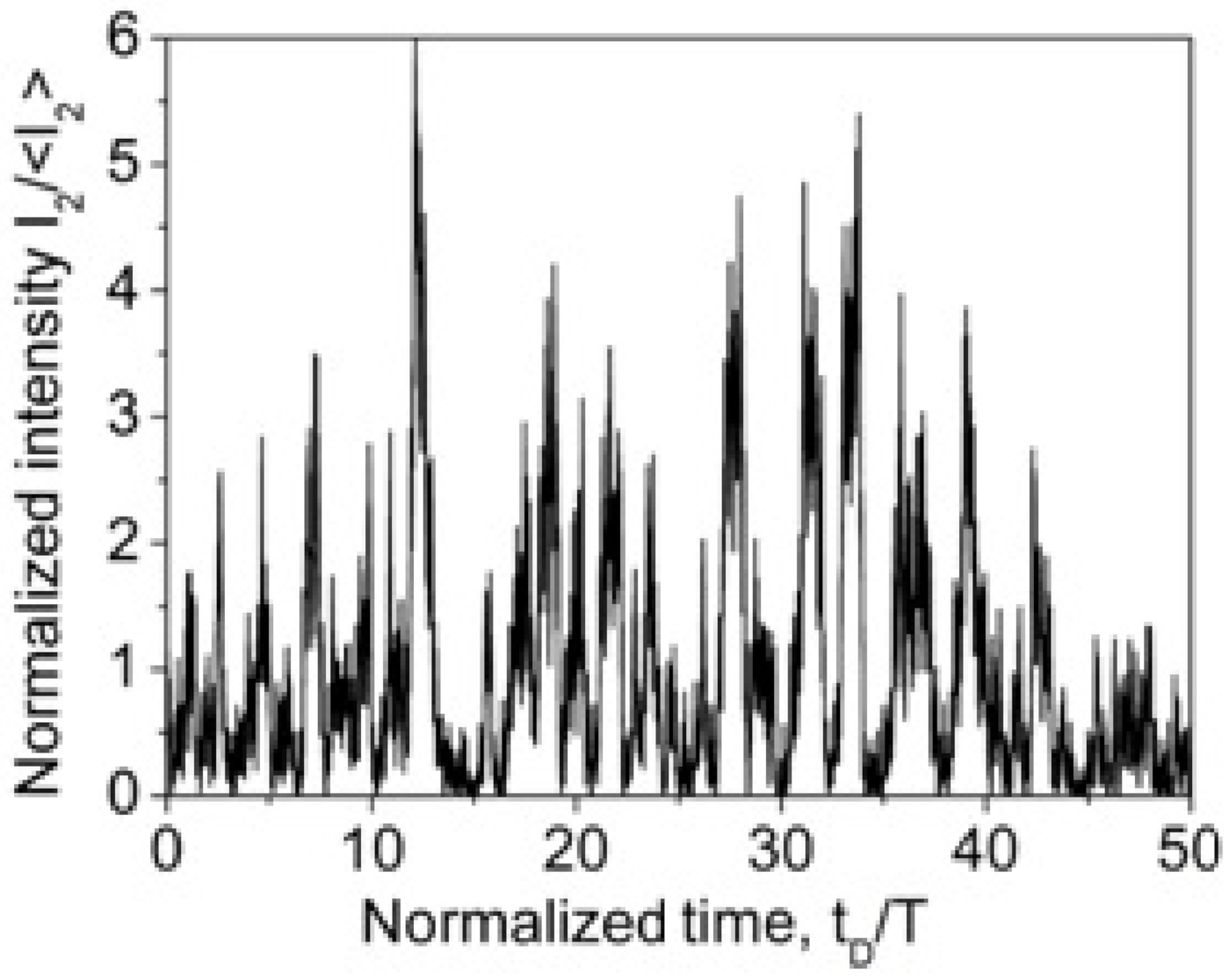
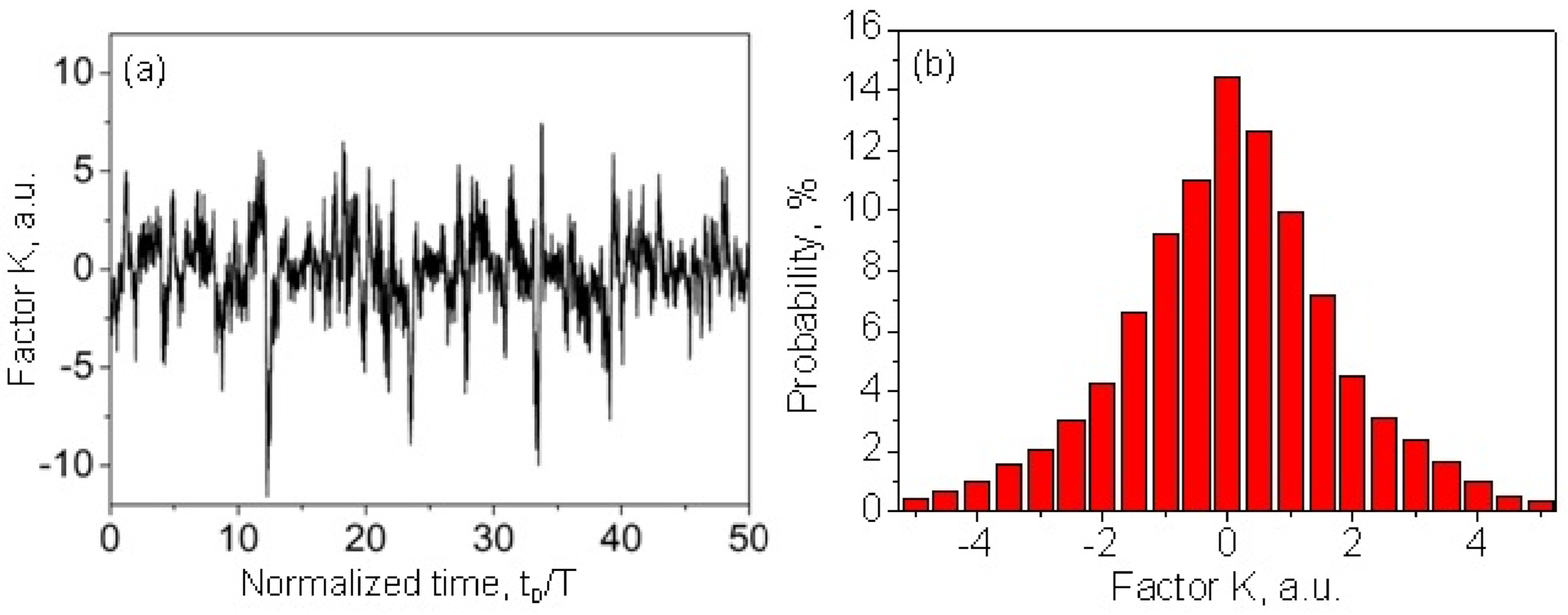
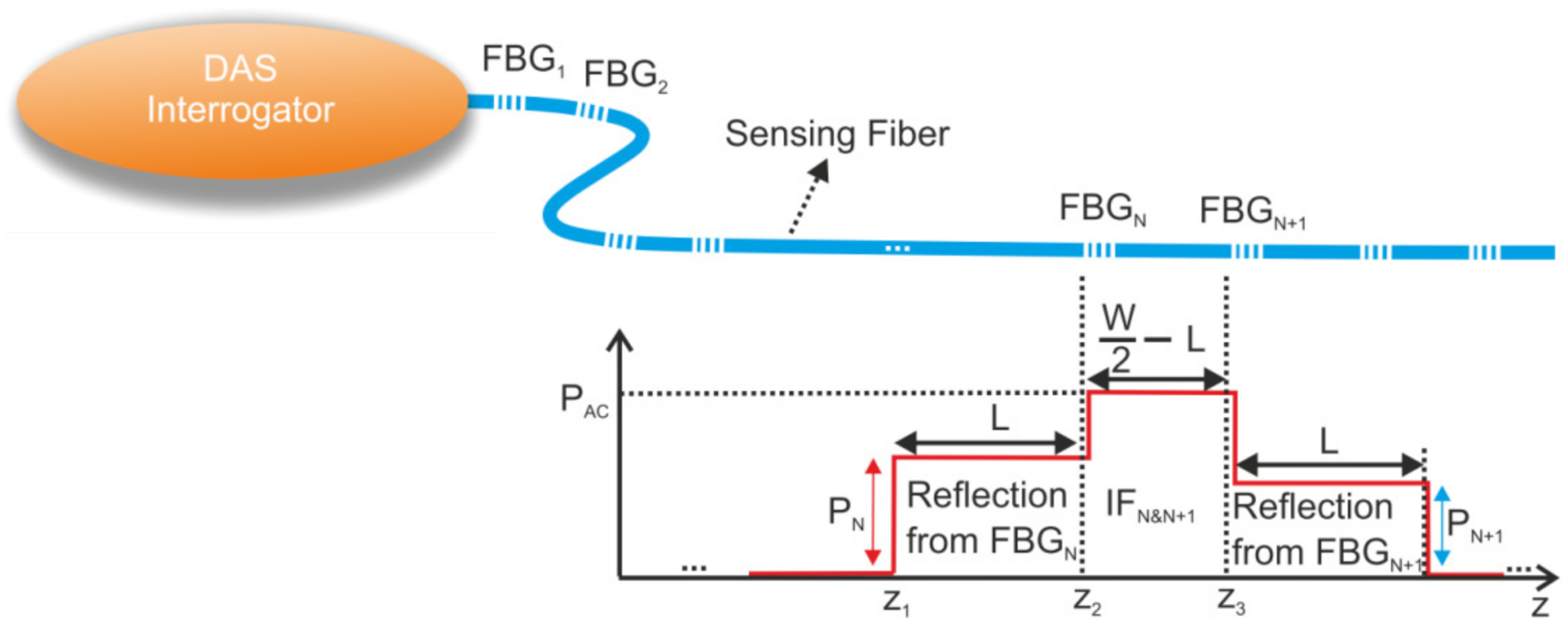

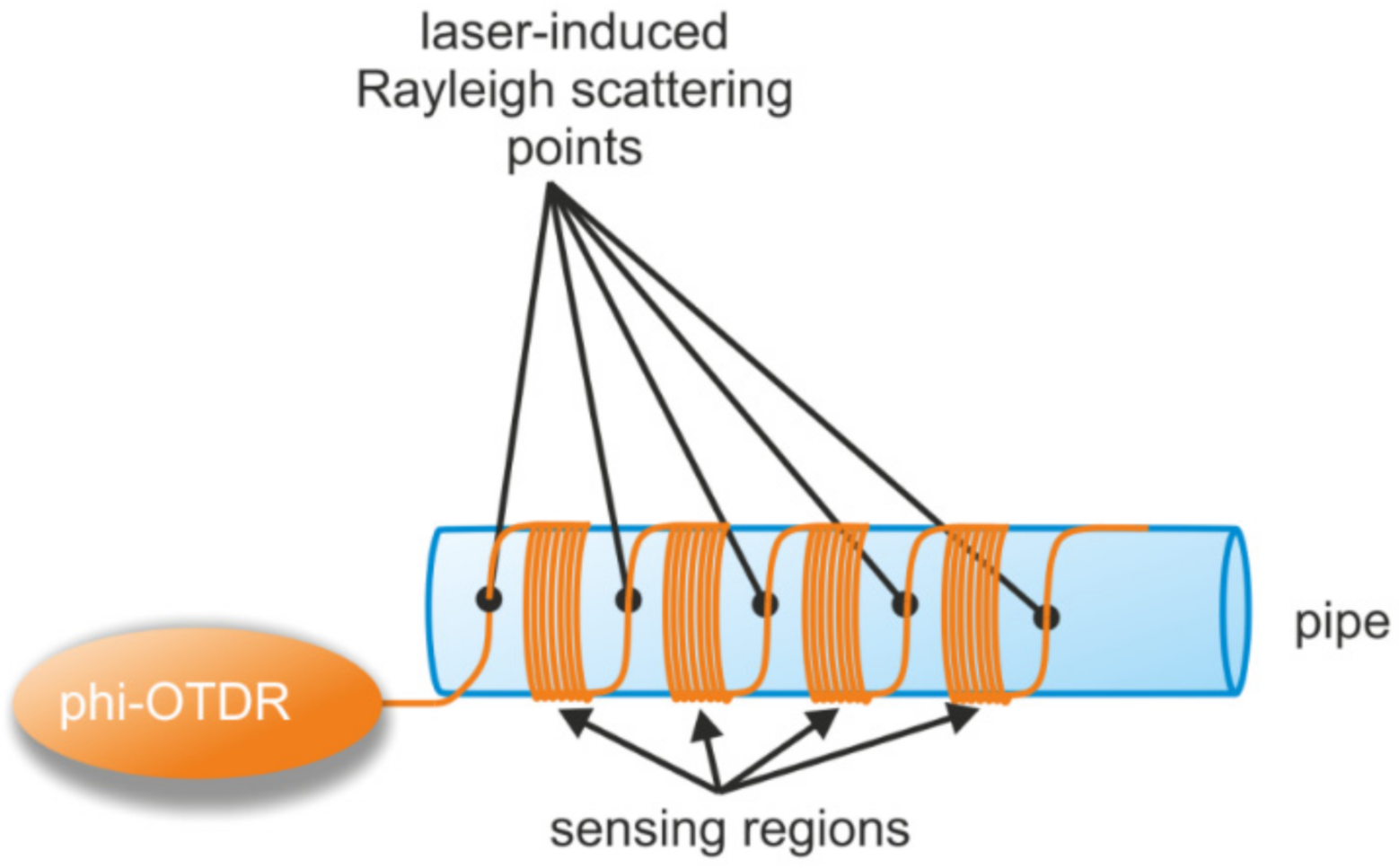
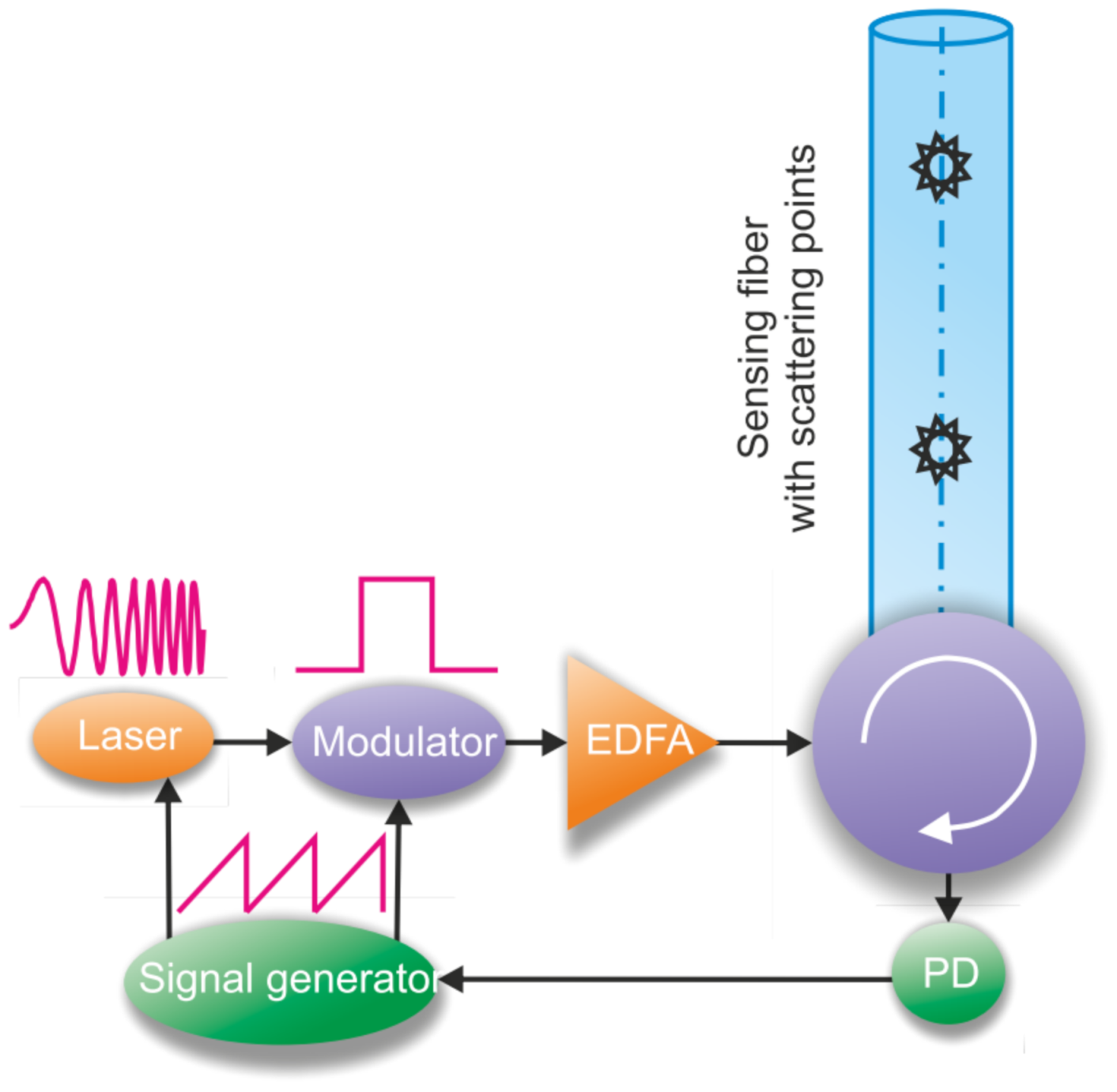
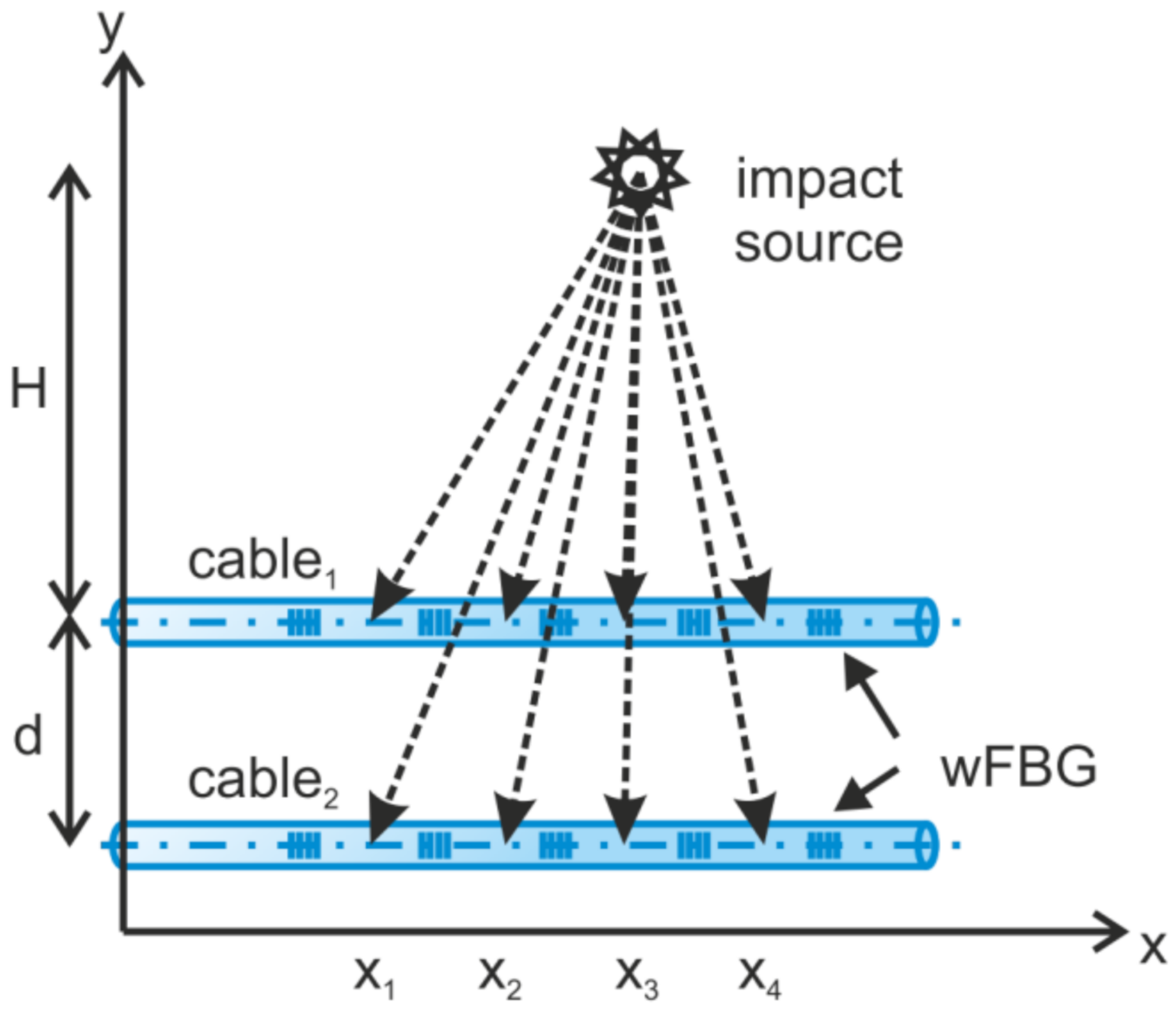

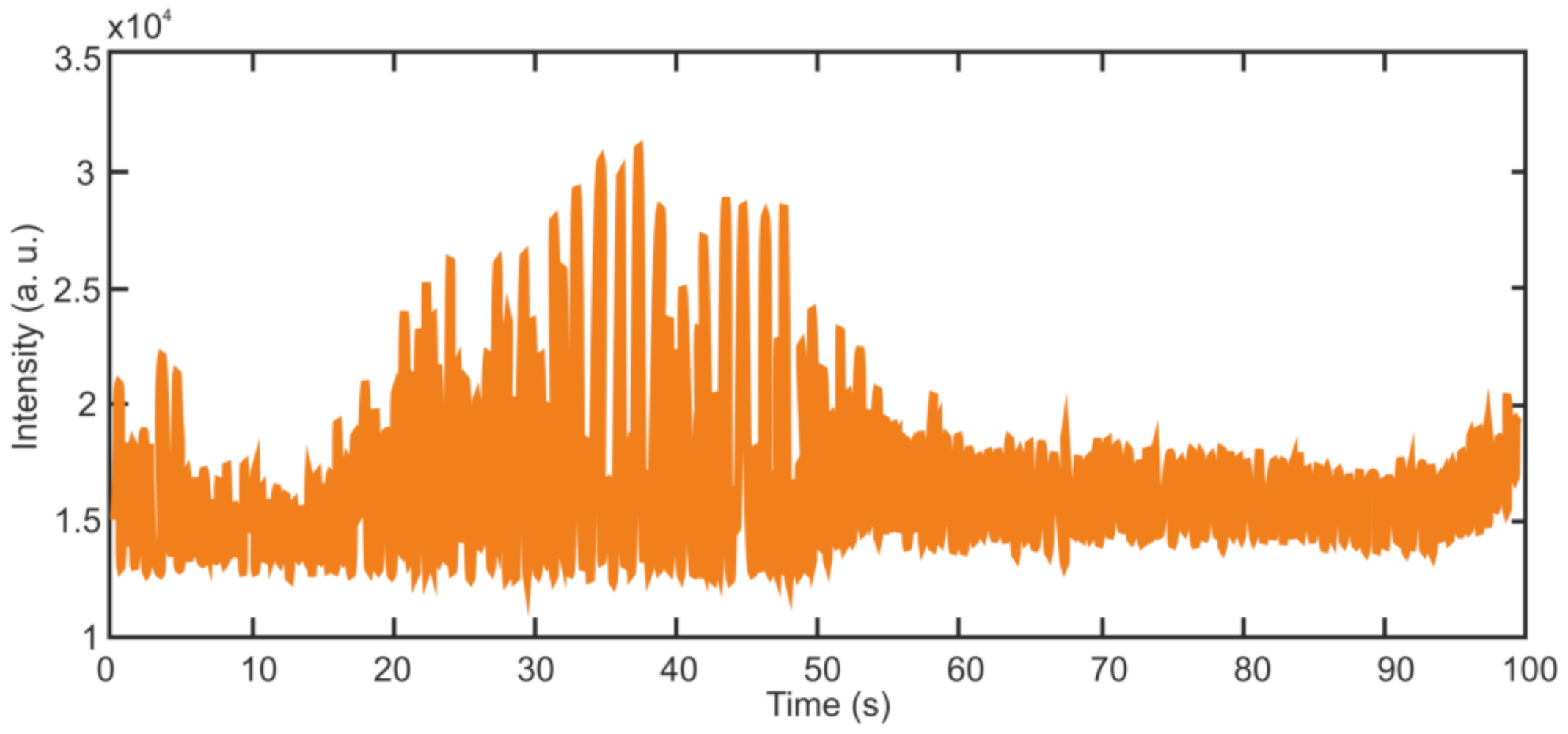



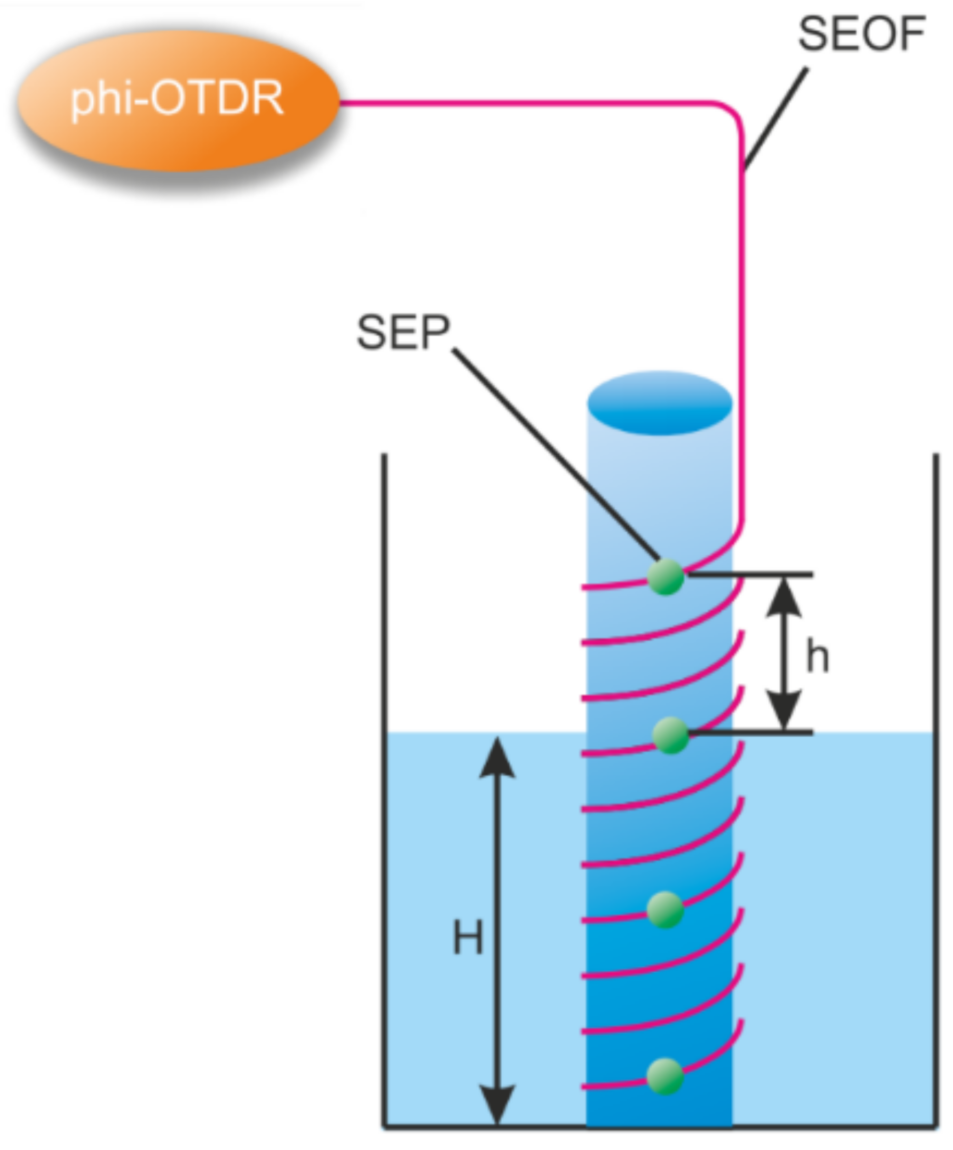
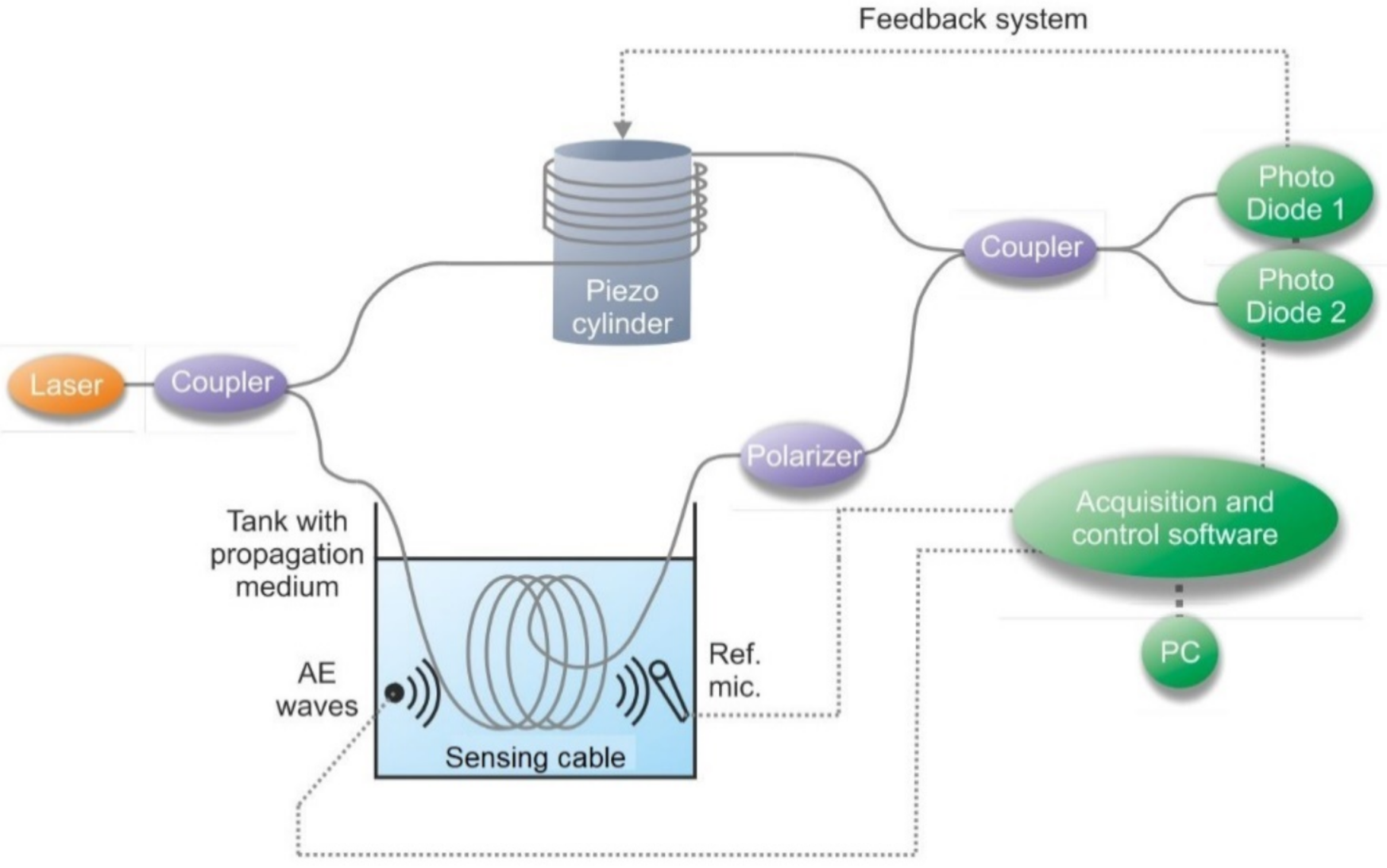
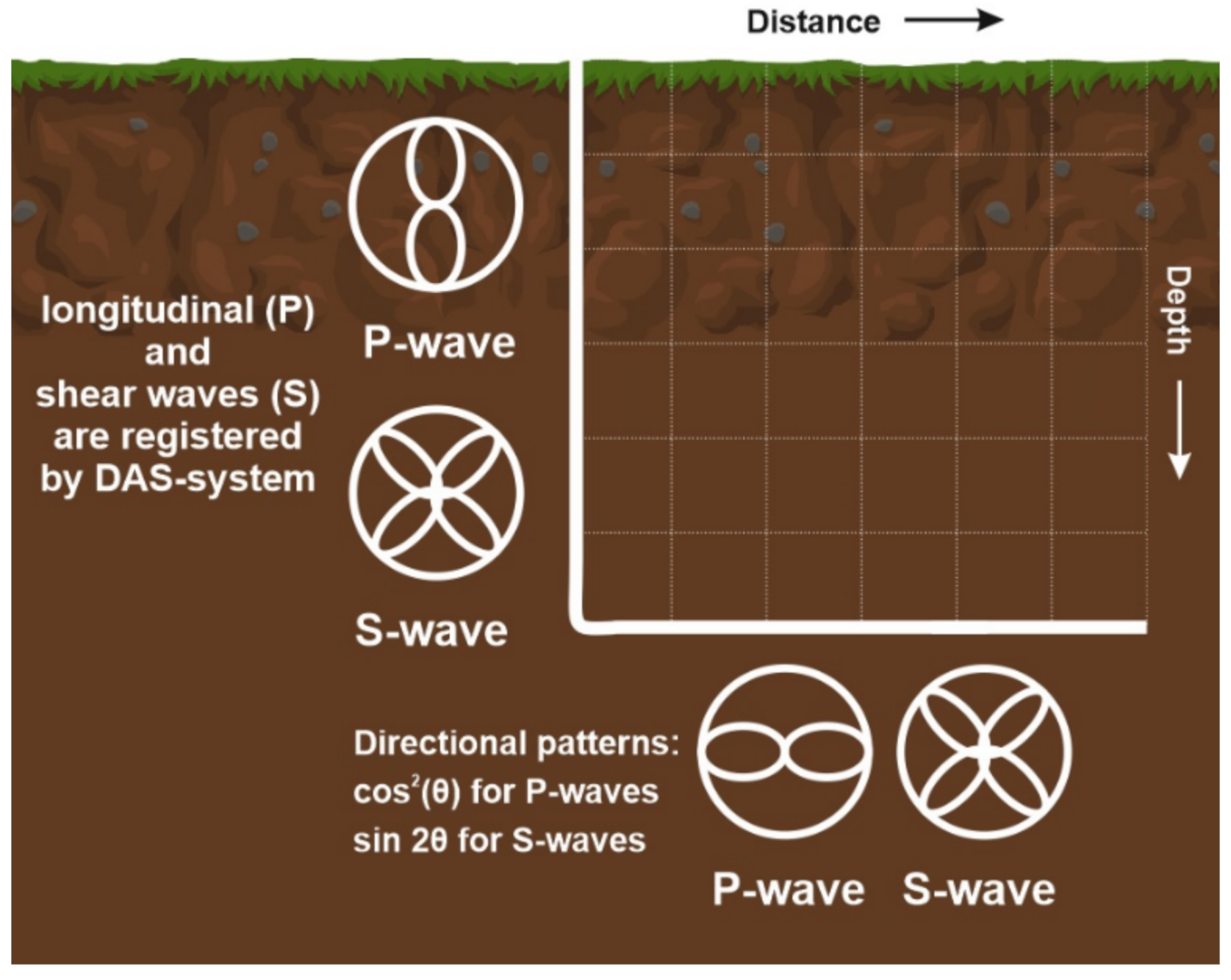


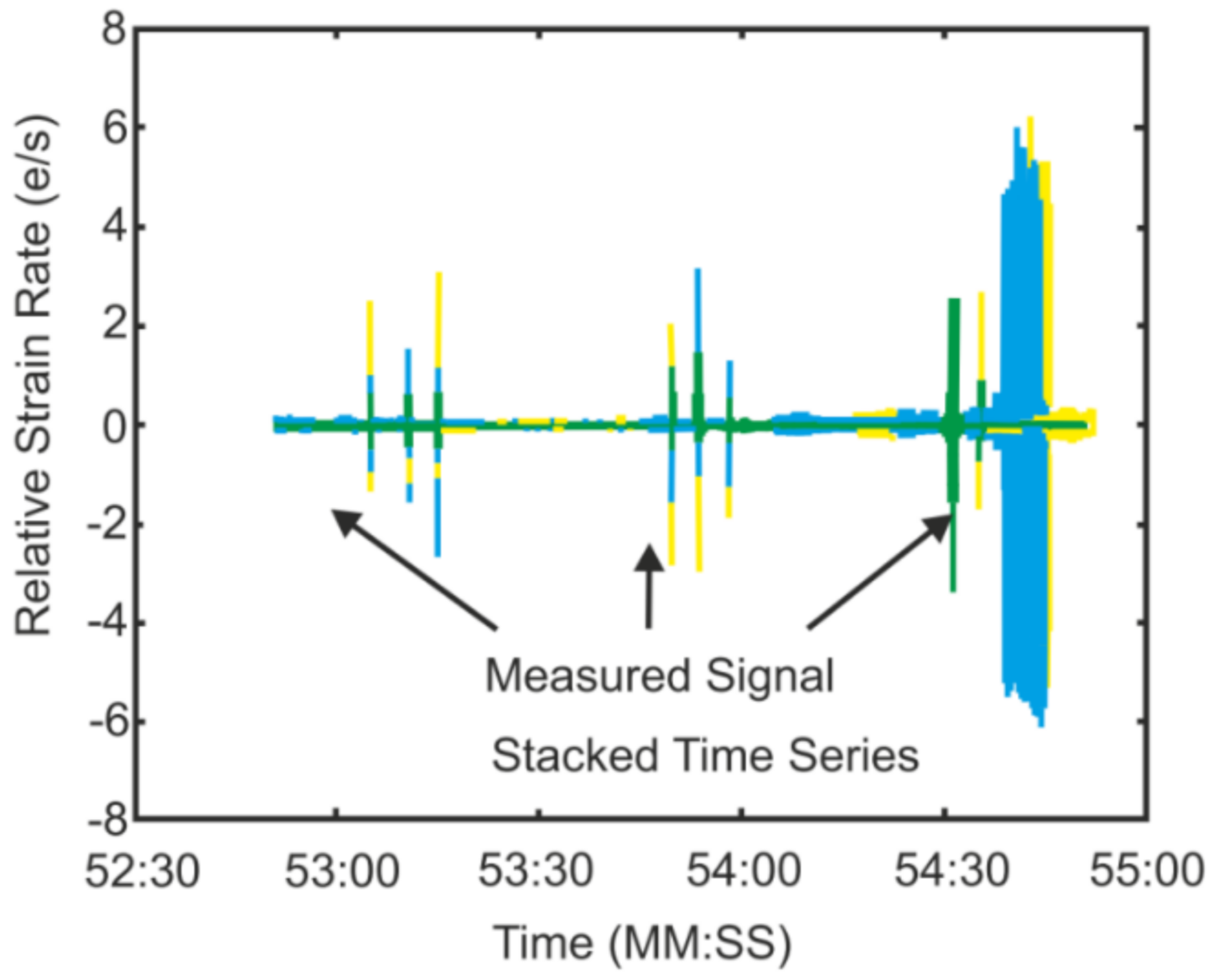

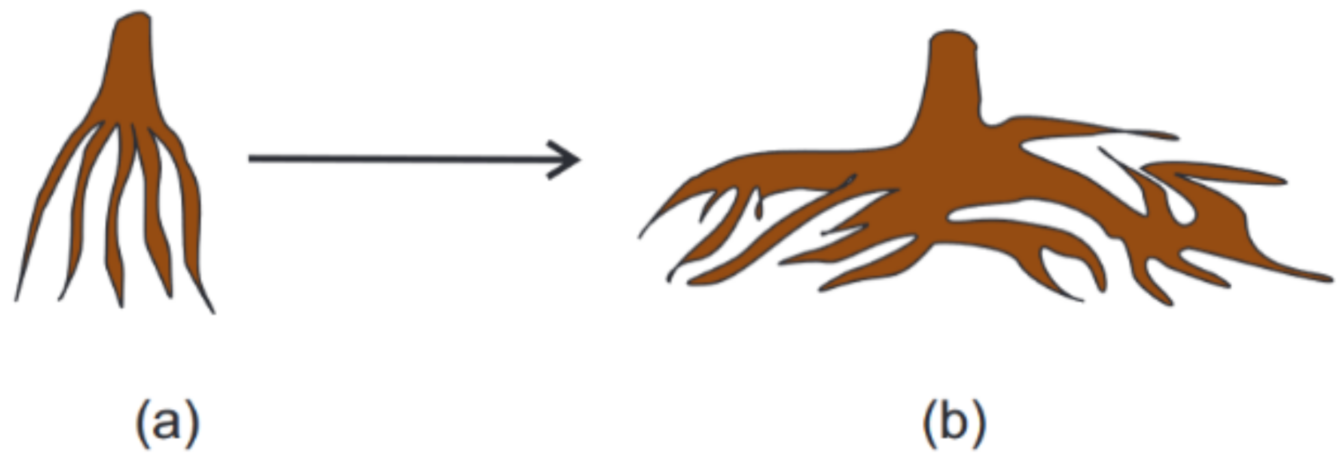
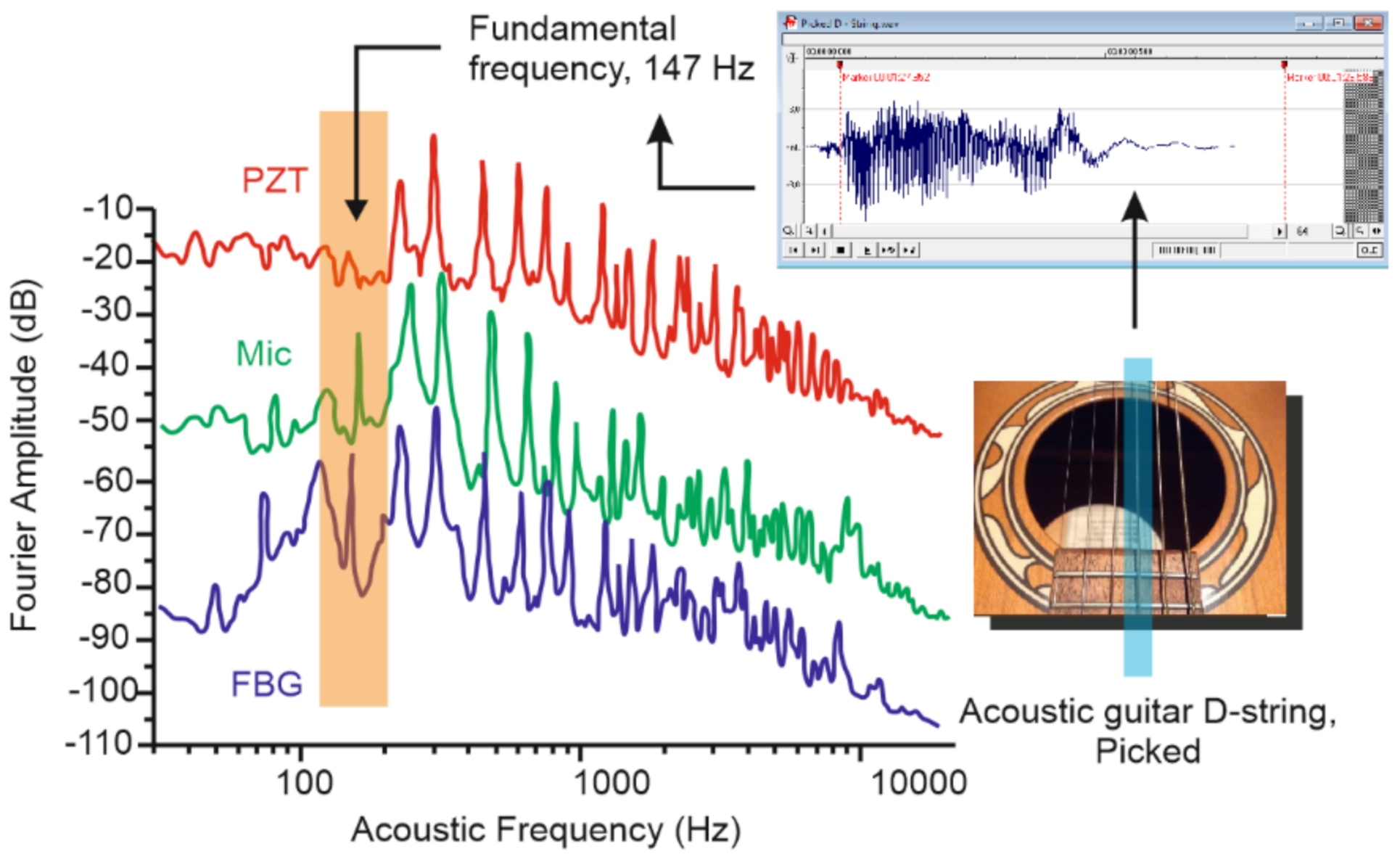


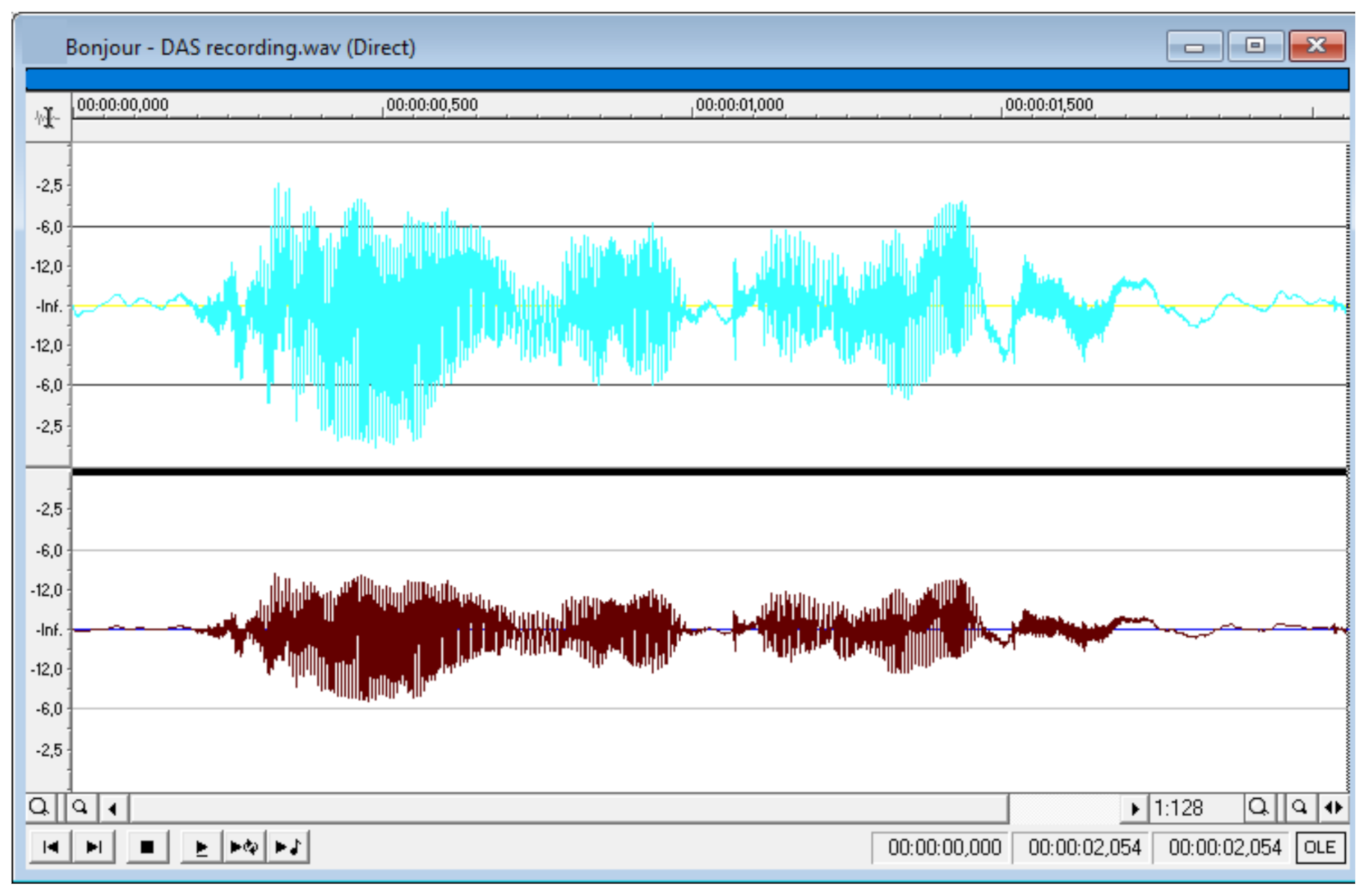

| Area of Interest, Requirements | Freq. Ranges | Digitizing Bitrate | Processing Delay | Integration to the Area |
|---|---|---|---|---|
| Geophysics | from 0.05 to tens of Hz | Usually 8 bits | from 0.5 s to few seconds | High |
| Engineering | From Hz to hundreds of kHz | Usually 8 bits | from 0.5 s to few seconds | High |
| Biology | Usually within 20 Hz–20 kHz | N/A | N/A | Low |
| Arts | 20 Hz–20 kHz | 24–32 bits | <20 ns for live recording, N/A for studio | Medium |
| Best achieved * | 0.001 Hz [180]–80 kHz [181] | 16 bits [182] | 1 ms [183] | N/A |
Publisher’s Note: MDPI stays neutral with regard to jurisdictional claims in published maps and institutional affiliations. |
© 2022 by the authors. Licensee MDPI, Basel, Switzerland. This article is an open access article distributed under the terms and conditions of the Creative Commons Attribution (CC BY) license (https://creativecommons.org/licenses/by/4.0/).
Share and Cite
Gorshkov, B.G.; Yüksel, K.; Fotiadi, A.A.; Wuilpart, M.; Korobko, D.A.; Zhirnov, A.A.; Stepanov, K.V.; Turov, A.T.; Konstantinov, Y.A.; Lobach, I.A. Scientific Applications of Distributed Acoustic Sensing: State-of-the-Art Review and Perspective. Sensors 2022, 22, 1033. https://doi.org/10.3390/s22031033
Gorshkov BG, Yüksel K, Fotiadi AA, Wuilpart M, Korobko DA, Zhirnov AA, Stepanov KV, Turov AT, Konstantinov YA, Lobach IA. Scientific Applications of Distributed Acoustic Sensing: State-of-the-Art Review and Perspective. Sensors. 2022; 22(3):1033. https://doi.org/10.3390/s22031033
Chicago/Turabian StyleGorshkov, Boris G., Kivilcim Yüksel, Andrei A. Fotiadi, Marc Wuilpart, Dmitry A. Korobko, Andrey A. Zhirnov, Konstantin V. Stepanov, Artem T. Turov, Yuri A. Konstantinov, and Ivan A. Lobach. 2022. "Scientific Applications of Distributed Acoustic Sensing: State-of-the-Art Review and Perspective" Sensors 22, no. 3: 1033. https://doi.org/10.3390/s22031033
APA StyleGorshkov, B. G., Yüksel, K., Fotiadi, A. A., Wuilpart, M., Korobko, D. A., Zhirnov, A. A., Stepanov, K. V., Turov, A. T., Konstantinov, Y. A., & Lobach, I. A. (2022). Scientific Applications of Distributed Acoustic Sensing: State-of-the-Art Review and Perspective. Sensors, 22(3), 1033. https://doi.org/10.3390/s22031033








